OCTOBER ON THE TANGERINE TREE
In October, the small, shrub-like tangerine tree in my backyard is covered with colorful fruits and quite a few interesting small arthropods.
Some of those creatures feed on the plant. Others are predators. Some of them prosper on the rotting fruits that fall on the ground from time to time.
The presence of various species isn't exactly the same every year.
These shield bugs, for example, were very numerous only in October of 2022, as far as I can remember. Here you can see the nymphs. Young, wingless specimens.
The name of the species is Halyomorpha halys. In this picture made of two photographs, you can see the adults.
These bugs are very fond of ripe fruits.
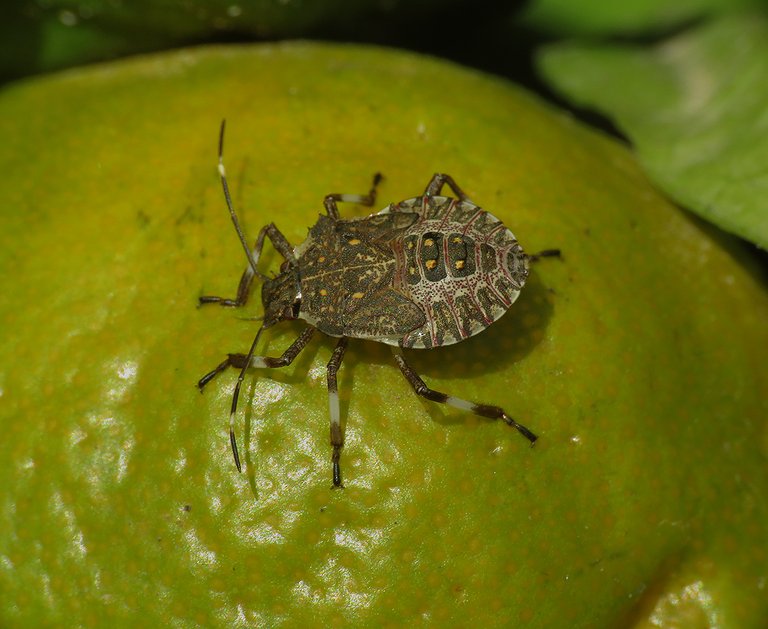
Both, the adults and nymphs, pierce the fruits or other parts of the plant with their proboscis and suck the juices. This photograph was taken on the 1st of October. Some fruits were still green back then. On the 13th of October, when the following photograph was taken ...
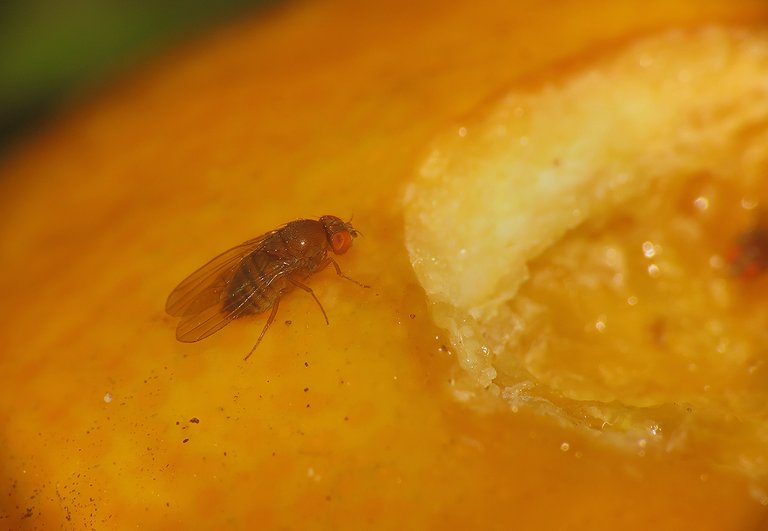
... all the tangerines were completely ripe.
Some fruits were starting to rot. That attracted a multitude of fruit flies. In the following photograph ...
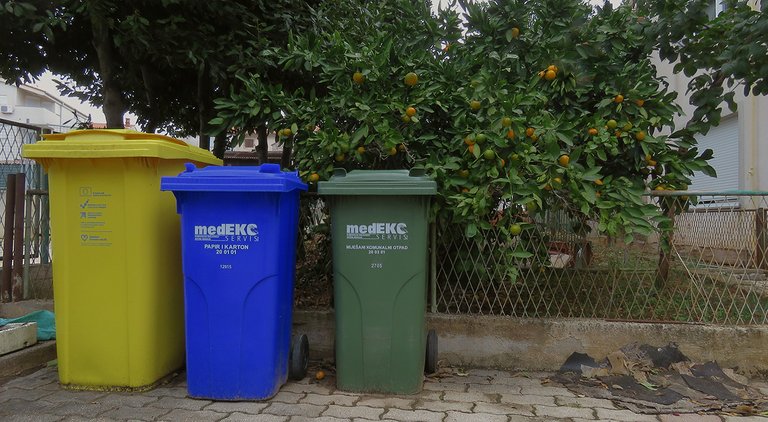
... I got out of the macro view to show you the wider setting. The corner of my yard in which the tangerines grow.
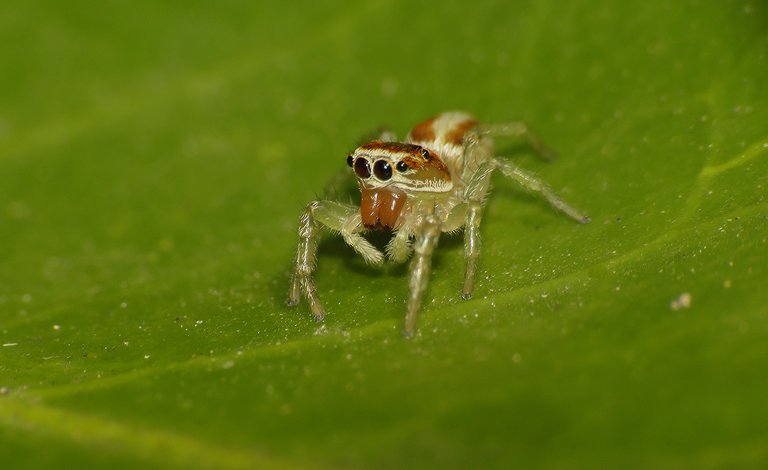
Here you can see a small predator that was crawling and jumping around on the 2nd of October.
It's a jumping spider. The Icius hamatus jumping spider. The family is Salticidae, of course.
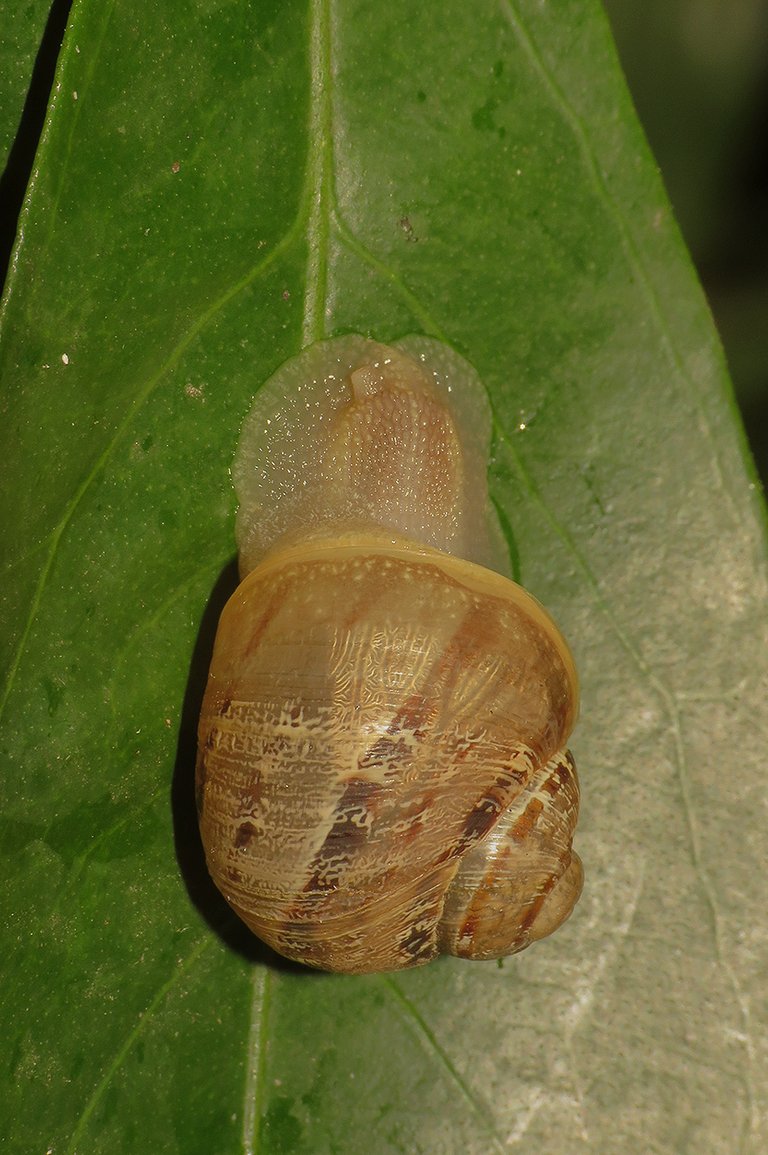
In the middle of a bright, sunny day, the snails can be resting on the leaves, sealed in their spiral shells. But if the weather gets cloudy ...
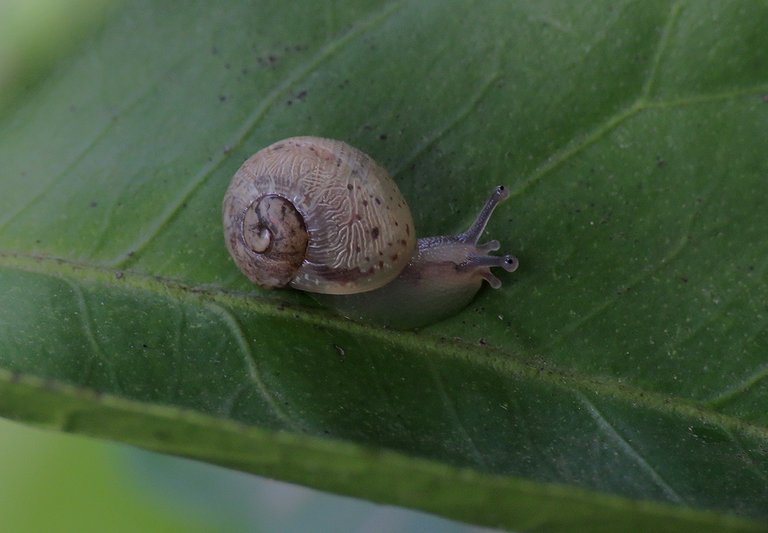
... or, even better, if a bit of unpredictable rain falls ...
... you can see them crawling on the branches, fruits, and leaves.
You can also see them early in the morning no matter the weather. Mornings in my yard are always fresh and humid in October.
The snails are active during the night as well. But I don't go chasing them at night. Although pretty slow, these snails are very agile and acrobatic in their own measured way. The snail shown in this photograph was climbing from one leaf to another.
This and all the other snails in the post belong to the Helicidae family. Cornu aspersum is the name of the species.
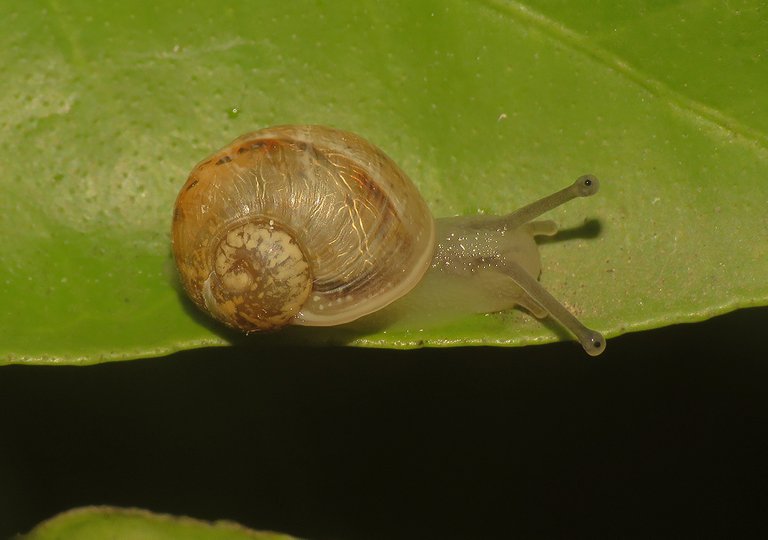
Cornu aspersum is a fairly big snail. A medium-sized snail, I'll say. But practically all the specimens I showed you so far are very small. That's because they are young. Their shells are still at least partially translucent.
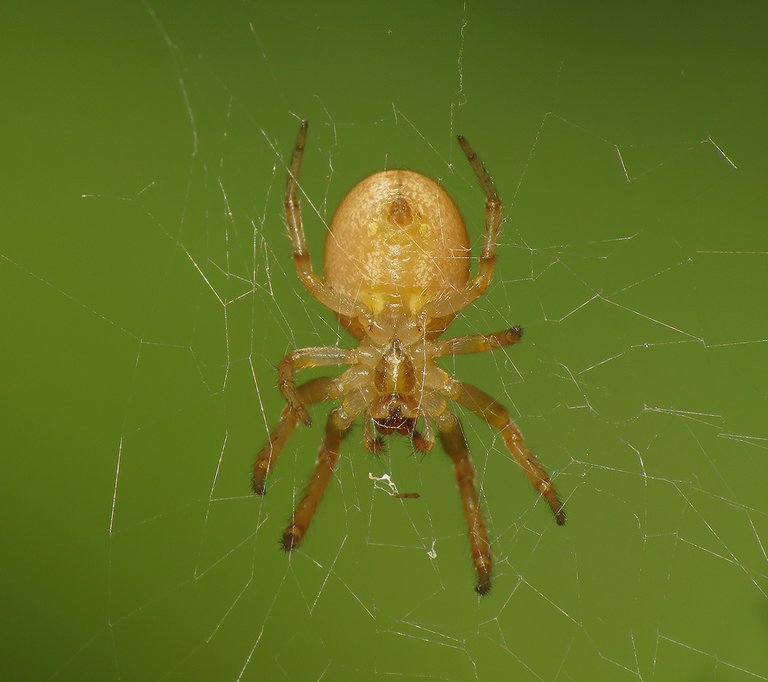
Here you can see a spider that I wasn't able to identify. The family is probably Araneidae.
If you enlarge this photograph by clicking on it, you'll notice that the spider is feeding on some very small insect. I think that the prey is a gnat. Gnats are small, mosquito-like flies from the suborder Nematocera. Various species from various families are commonly called gnats.
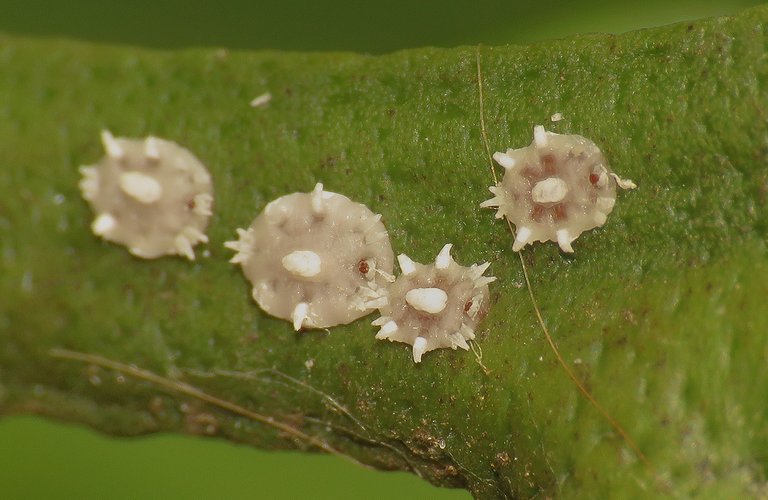
Scale insects can be seen on the tree all year round. These are the Ceroplastes japonicus, wax scales from the Coccidae family. The insects shown in this photograph are young females.
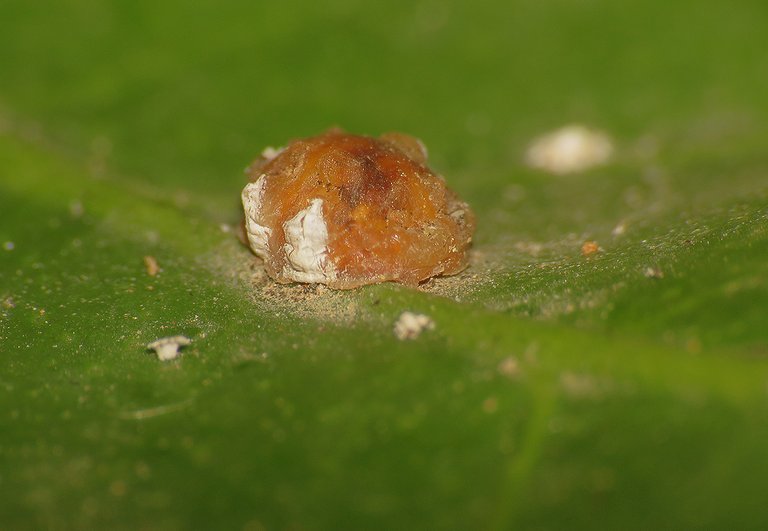
Here you can see an old female near the end of its life cycle.
The very young nymphs are still able to move. As adults, females are completely immobile with no recognizable features that one associates with insects. The wax scales feed on leaves and twigs. Well, usually. Sometimes ...
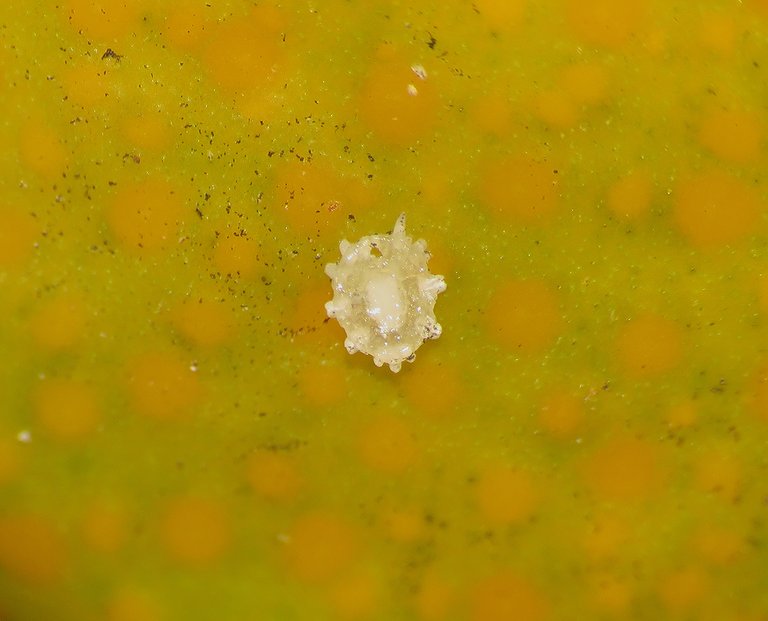
... I found a scale or two on the fruits as well.

This lovely little beetle is a predator.
The name of the species is Exochomus quadripustulatus. The family is Coccinellidae.
It's a ladybeetle. One of the smaller ones in this area.
Here you can see it attacking the waxy fortress of the Ceroplastes japonicus.
Both adults and larvae feed on scale insects and aphids. I followed the ladybeetle for a couple of minutes, and then ...
... the small scale-hunter continued its daily routine on the other side of the leaf.

The colors and the markings on the elytra are variable in this species. If you compare the beetle in this photograph to the one shown in the previous series of twelve shots, you'll notice some fairly small differences.
Most commonly, an adult Exochomus quadripustulatus is shiny black with two larger red comma-shaped spots and two smaller red round or oval spots.
I saw the most common version of the insect only on the Internet, never on my tangerine tree. In the following photograph ...
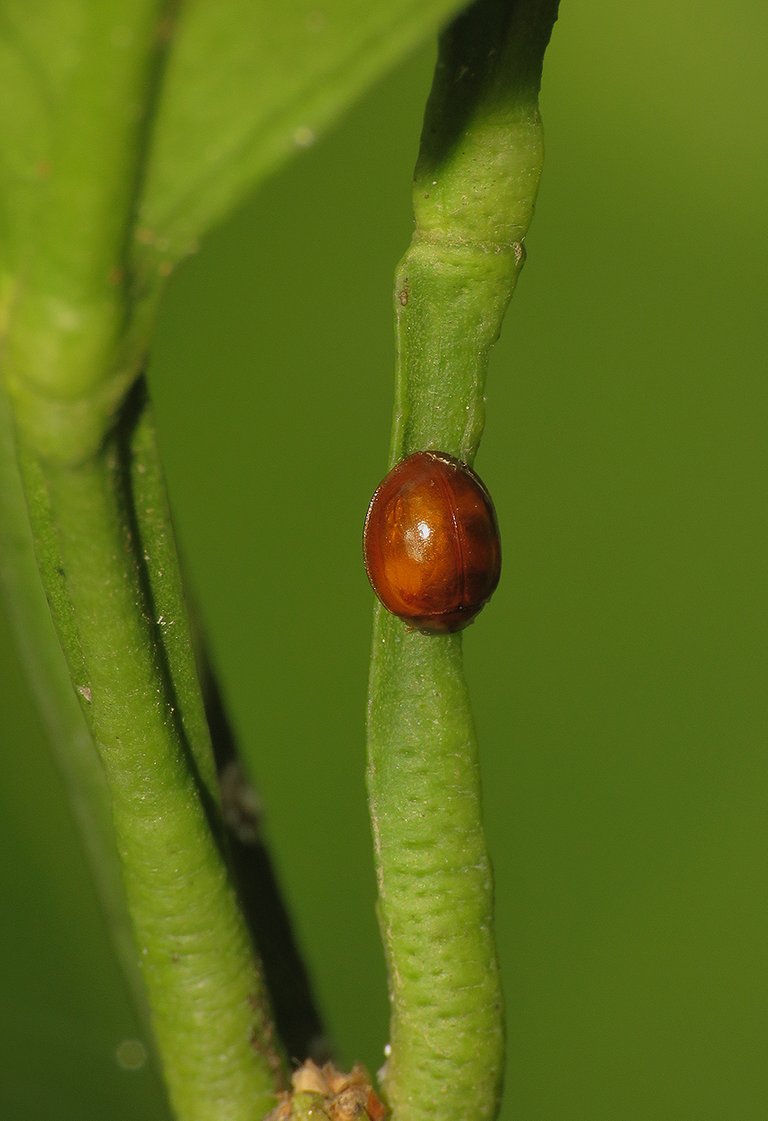
... you can see the variation with no spots on the amber-colored elytra.
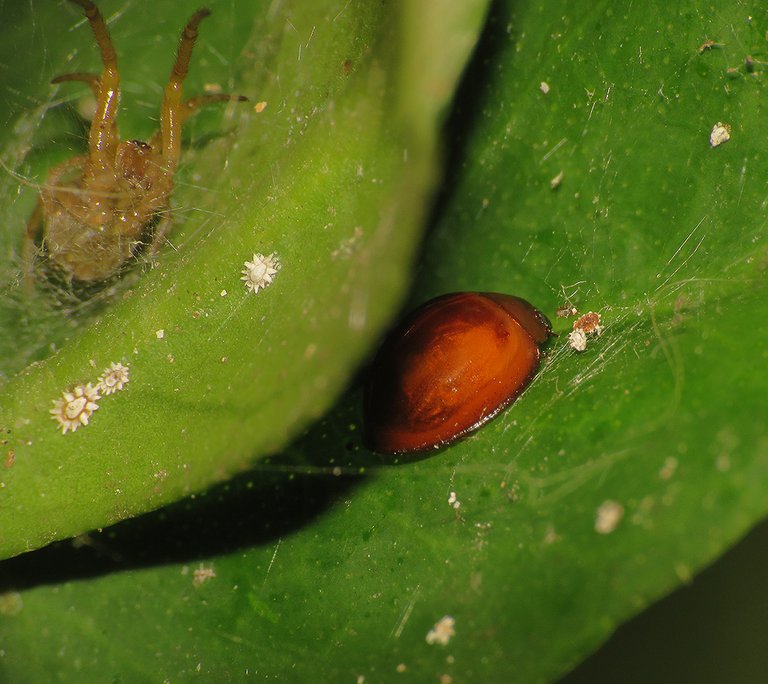
In this photograph, the beetle is resting under the leaf on which a spider has built its silky den.

The spider in question looks like some species from the genus Zygiella of the Araneidae family but I'm not completely sure about that. If I had to guess, I'll say that this is the Zygiella atrica.
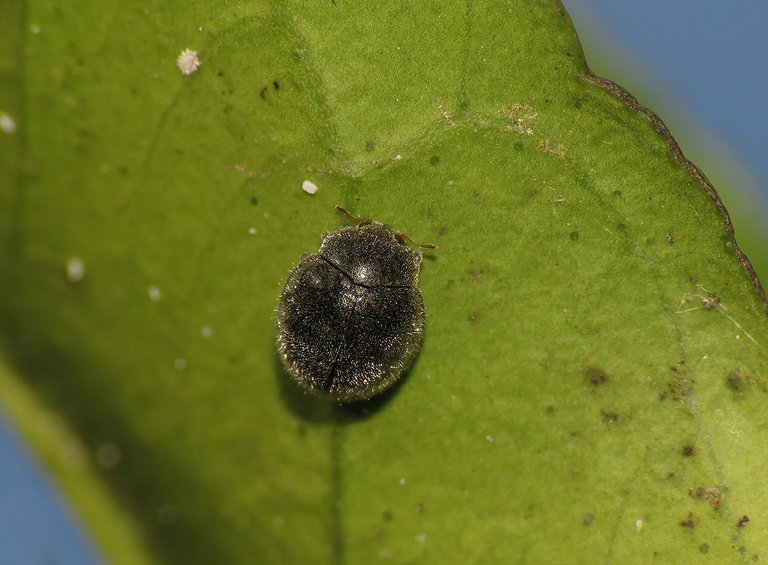
Exochomus quadripustulatus is a pretty small member of the Coccinellidae family, but some other lady beetles that can be seen on the tree are even smaller. Considerably smaller. Here you can see the Rhyzobius forestieri, a species native to Australia but also present in Europe since the eighties when it was introduced as a biological countermeasure to the invasive scale insects.

In this and the following shot, you can take a break from the macro view ...
... and enjoy the sight of the ripe fruits ready to be picked.
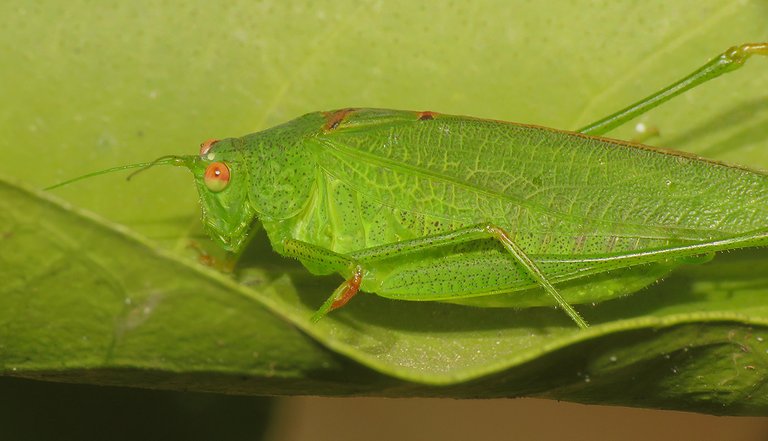
This bushcricket, the Phaneroptera nana ...
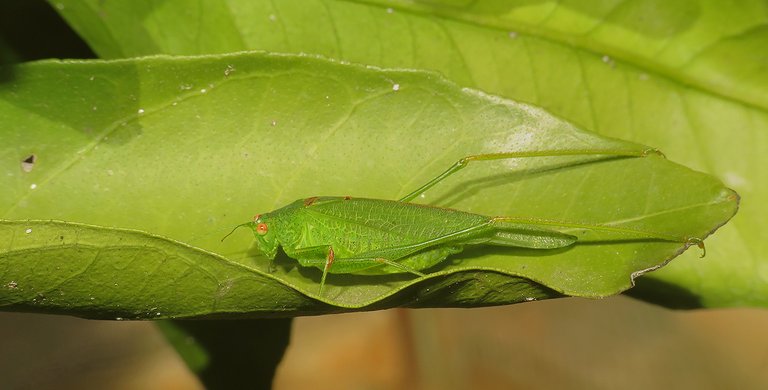
... is very hard to notice on the leaf. In the following photograph ...
... you can see a well-camouflaged arachnid.
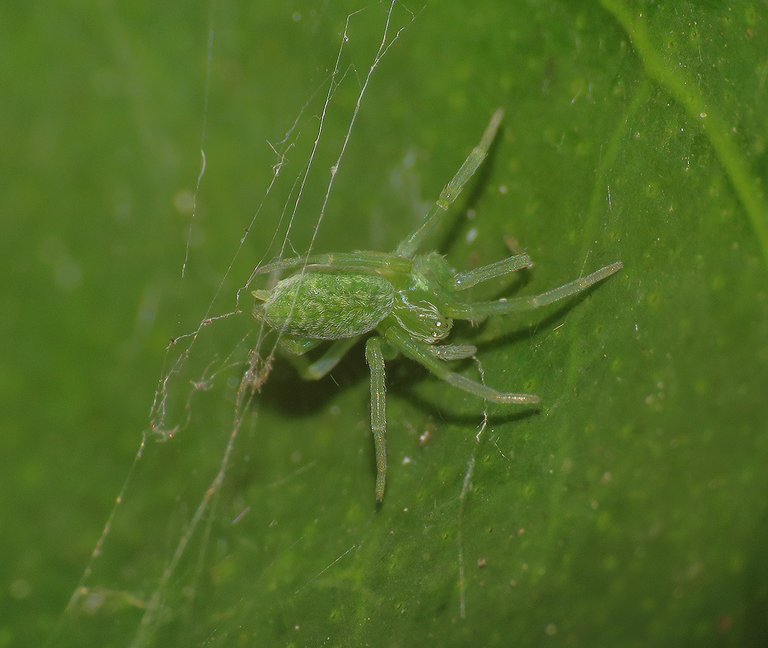
This is the Nigma walckenaeri ...
... commonly known as the green meshweaver.

A small spider from the Dictynidae family.
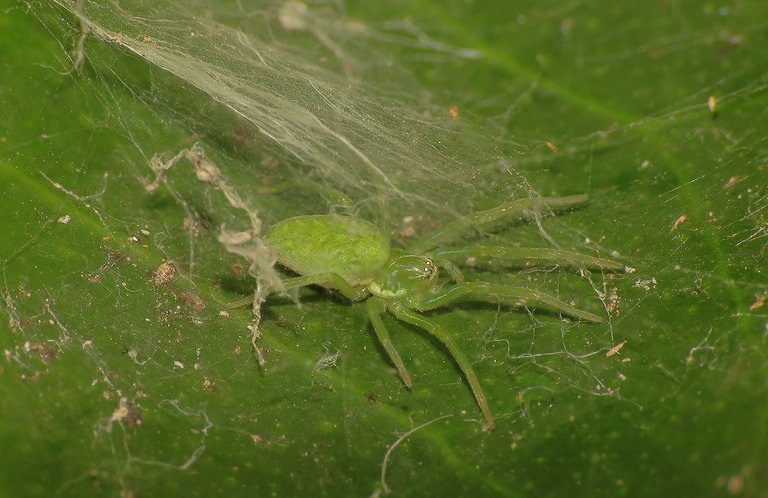
This species is very common on small trees and bushes in gardens and parks, often in urban and suburban areas.
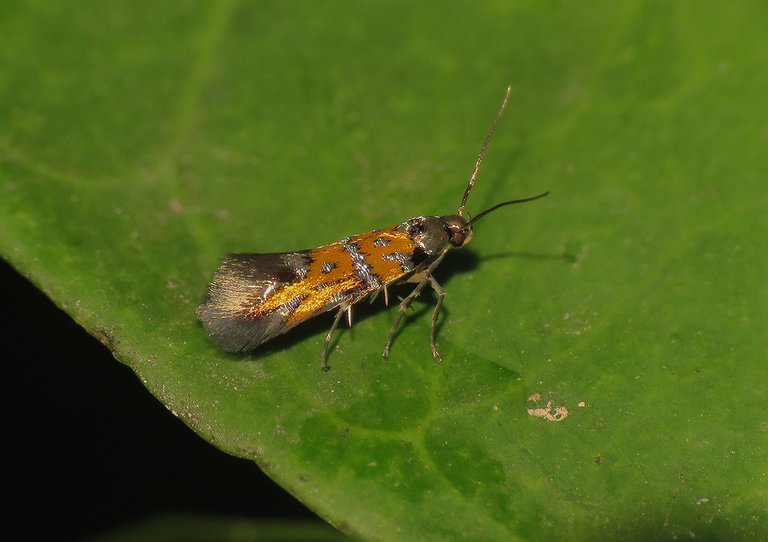
While sniffing around the tangerine tree on the 3rd of October 2022, I found a small moth that I have never seen before. This is the Chrysoesthia drurella, a moth from the Gelechiidae family.
Here you can see a spider that was hanging upside down on the web and feeding on its prey. The family is Araneidae and this time I'm pretty sure that this is the Zygiella atrica.
When it comes to the small silver fly shown in this photograph, I can't tell you the name of the species. But I know that the genus is Leucopis and the family is Chamaemyiidae. Because of their larval stage diet, flies from that family are commonly known as aphids fly. Besides feeding on aphids, larvae of the Chamaemyiidae flies from the genus Leucopis, eat also scale insects and mealybugs.
The mealybug shown in these two shots was photographed on the trunk of the nearby Syringa vulgaris tree.
At one point, while I was following the mealybug through the macro lens, a Crematogaster scutellaris ant entered the frame.
Here you can take another short break from the macro view.
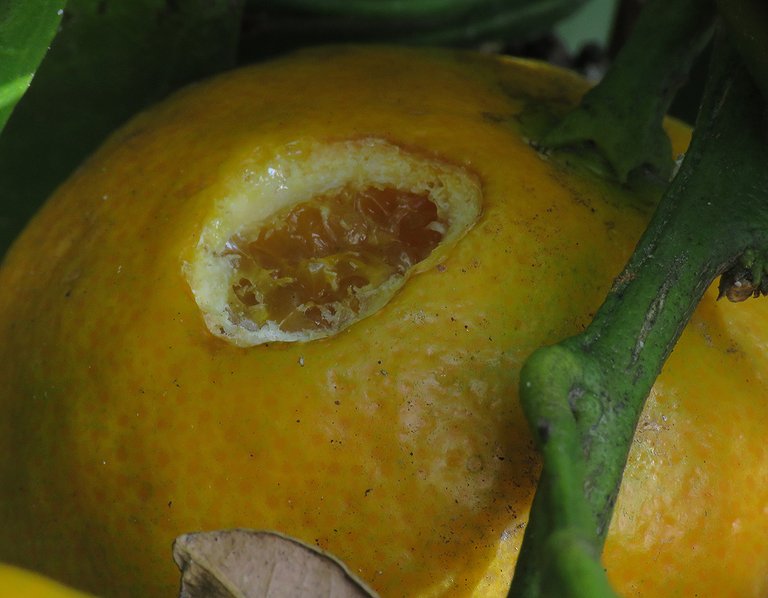
On the 5th of October, early in the morning, I noticed this fruit with a shallow hole in it. I don't know what ate the rind, but later that day ...
... I saw the Halyomorpha halys shield bug taking advantage of the situation by feeding on the deeper juicy tissue that is normally out of reach of these insects.
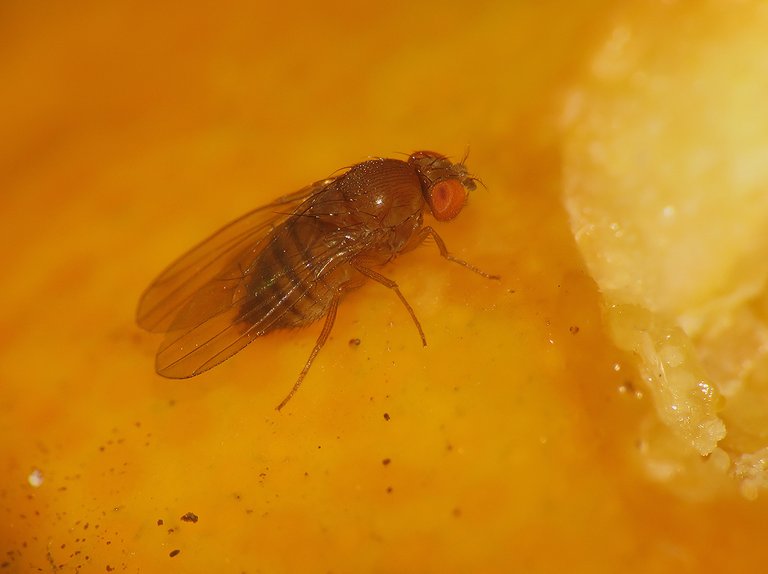
On the 10th of October ...
... the wound on the fruit was covered with tiny flies.
The name of this very common and widespread species from the Drosophilidae family is Drosophila melanogaster.
Both adults and larvae feed primarily on ripe and decaying fruits.

Here you can see Drosophila melanogaster on another tangerine. I mean, the tree is the same but it's another fruit. The fly is standing on a recently formed wound-like deformation of the fruit's rind that hasn't become a hole yet. The thing looks like an early stage of the wound-like formation shown in the previous photographs. In the following set of six shots ...
... the focus is again on that first hole. When I revisited the same fruit on the 13th of October ...
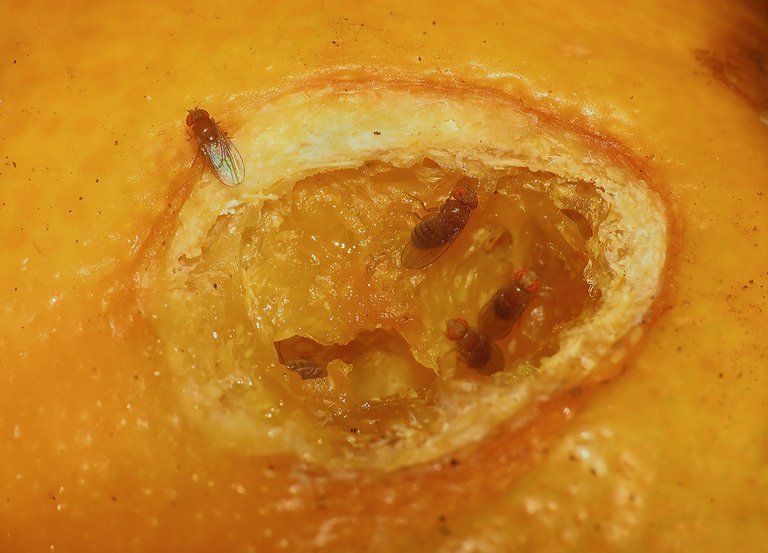
... the hole wasn't larger but it was much deeper.
On the 19th of October, the fruit fell on the ground.
When seen through the macro lens, its interior looked like a humid cave.
There was more empty space than juicy tissue under the rind.
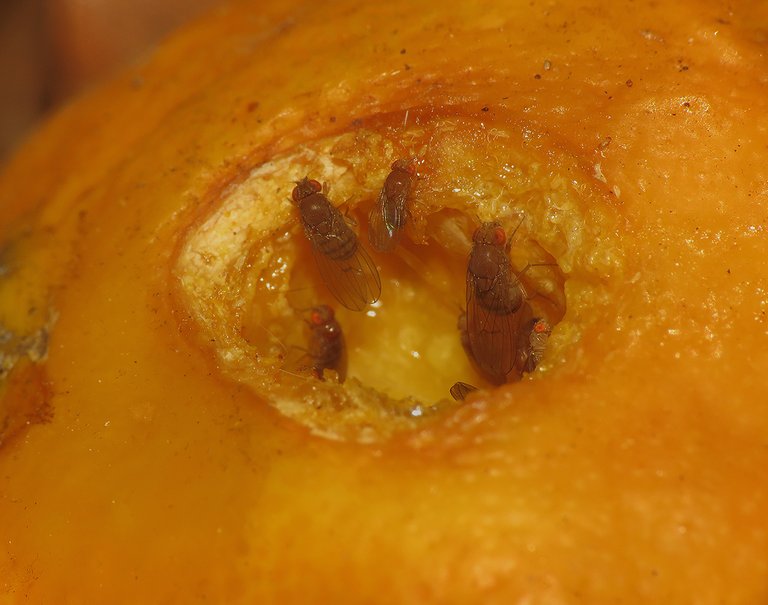
The usual fruit flies were there, of course ...
... but this time ...
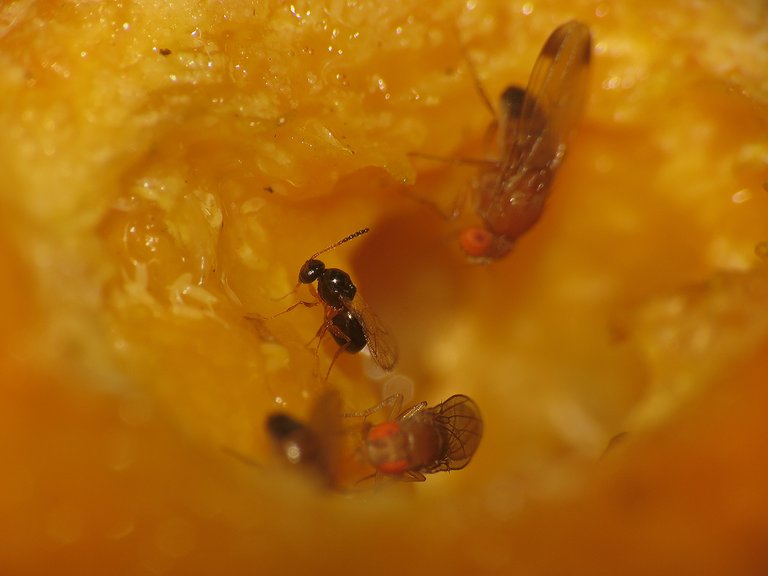
... I noticed another tiny insect among them.
This is the Leptopilina boulardi ...
... a parasitoid wasp from the Figitidae family ...
... that uses Drosophila melanogaster larvae as hosts for its offspring.
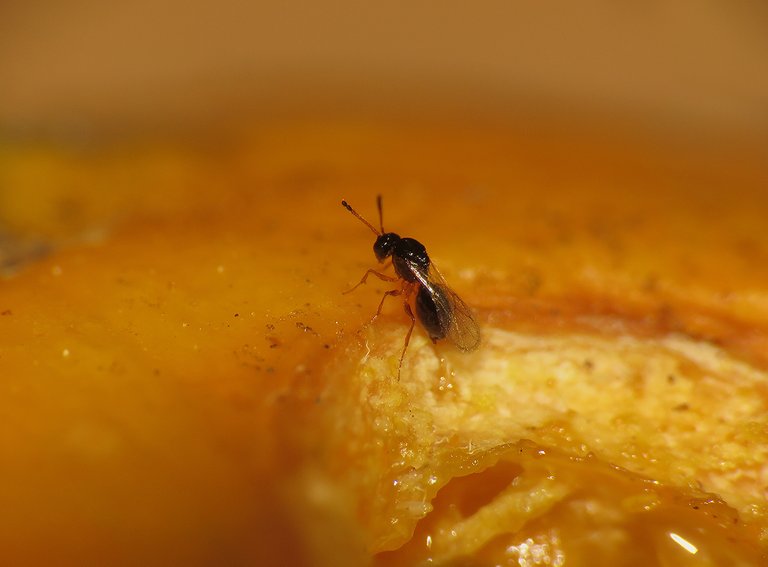
The venom released by the wasp during oviposition contains virus-like particles that delay host larval development and suppress its cellular immune response.
I never encountered this wasp before. That's not because it is a rare species.
Leptopilina boulardi is one of those tiny, inconspicuous insects that are really hard to notice if you don't look at them through some kind of magnifying lens.
Two Leptopilina boulardi wasps were present on the hollow tangerine fruit on the 19th of October. I took plenty of photographs on that occasion, I showed you many of them, so now ...
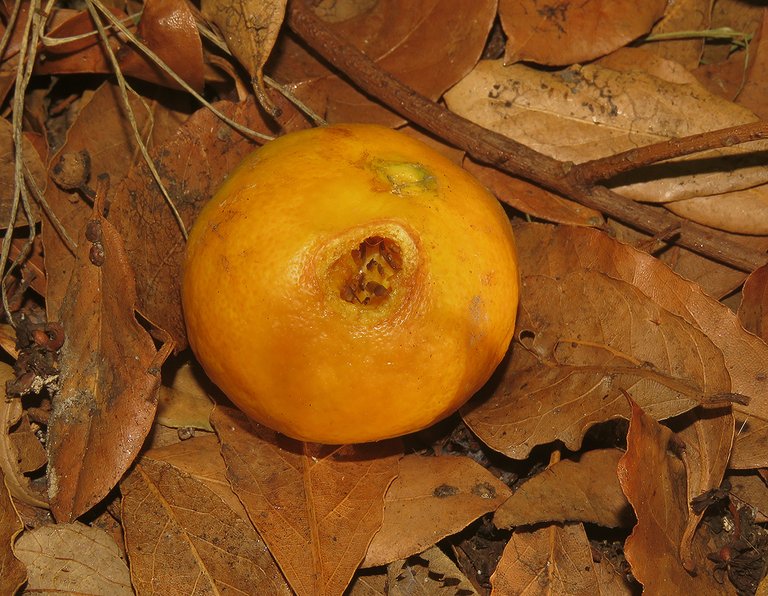
... is time to leave the scene and return ...
... to the tree on the 1st of October 2022.
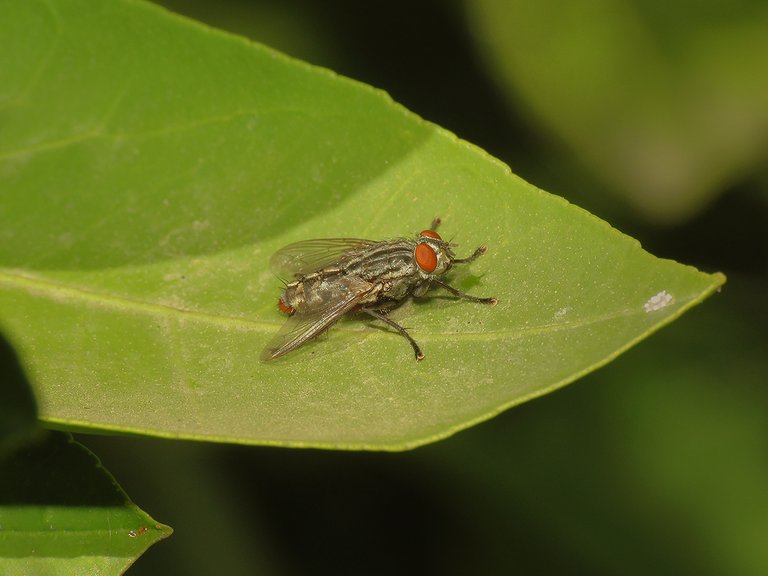
By doing so, the orange tone of the pictures will shift toward the green stretch of the spectrum.
Here you can see the Sarcophaga africa, a fly from the Sarcophagidae family.
This is the common green bottle fly ( Lucilia sericata) from the Calliphoridae family.
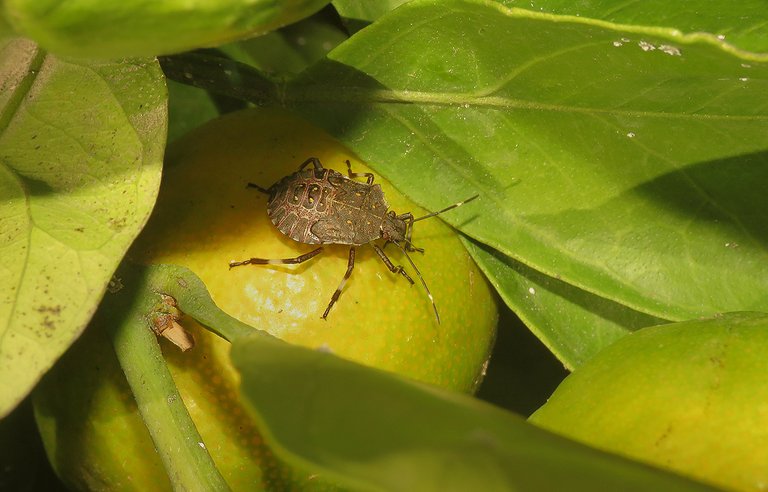
Here you can see a Halyomorpha halys nymph ...
... one of the many that could be seen in that period on the tree.
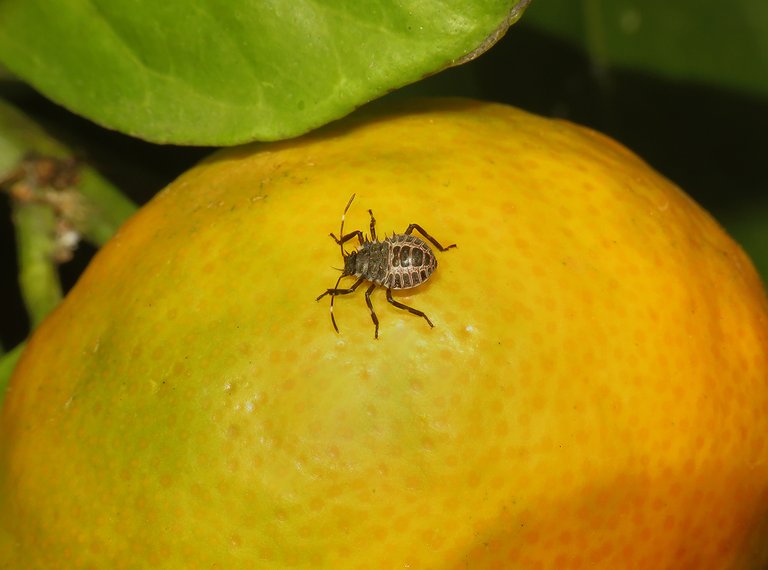
The young shield bugs were in various stages of development.
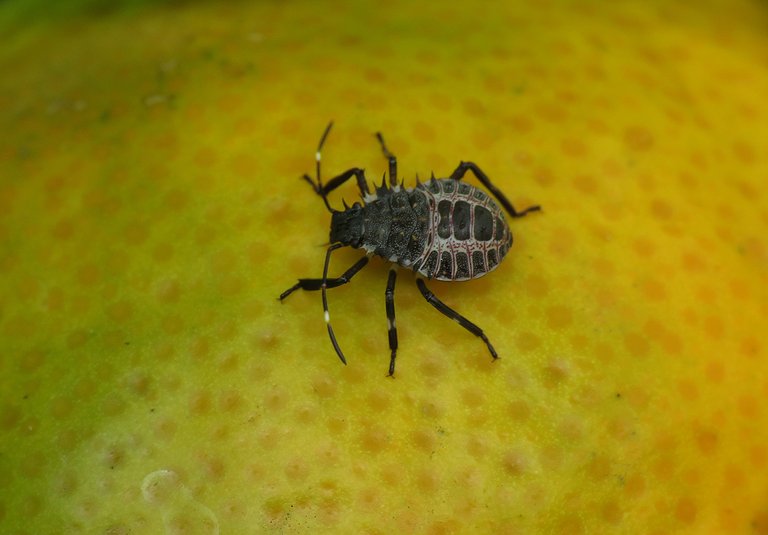
This one was much smaller. And younger. The shape and markings are also slightly different.
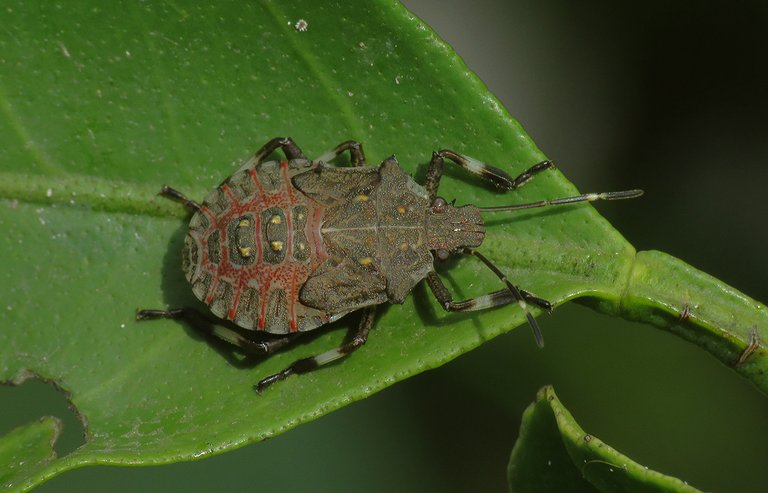
Besides getting bigger, after each molting, the nymph also changes a bit its appearance.
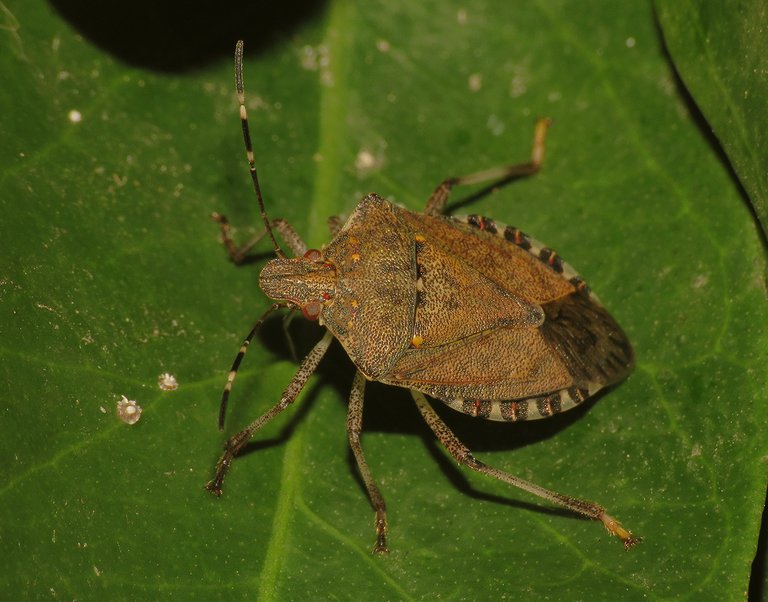
Here you can see an adult, completely developed Halyomorpha halys shield bug. In the following photograph ...
... three adults are feeding on the ripe fruit.

This small moth belongs to the Tortricidae family. The name of the species is Ditula angustiorana.
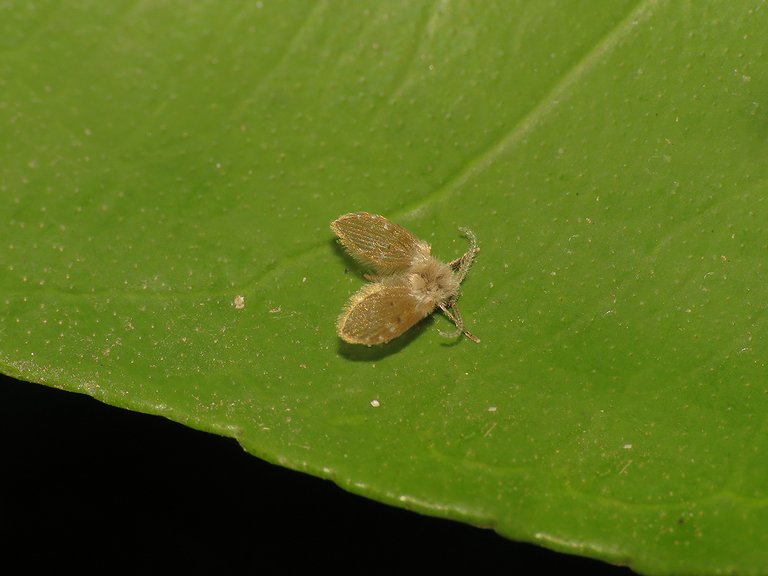
Here you can see an insect that looks like a tiny moth ...
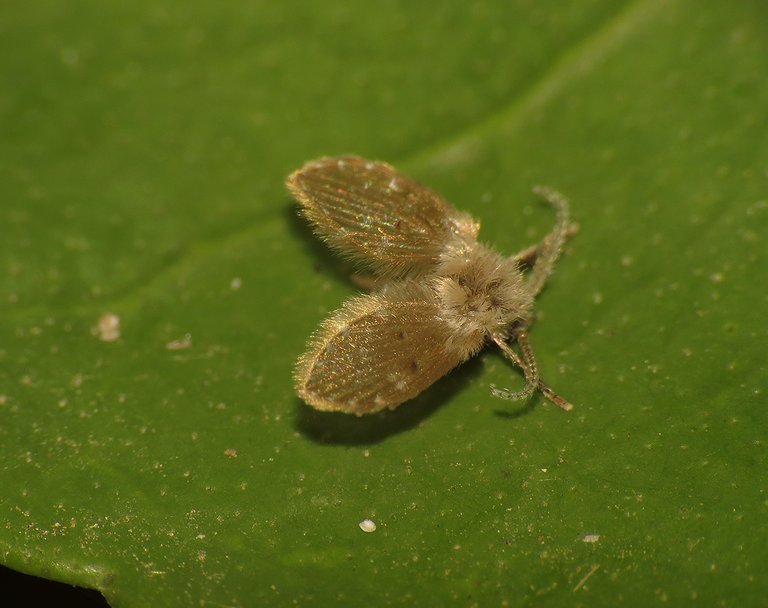
... but is actually a fly. The Clogmia albipunctata from the Psychodidae family.
This is a fly from the Rhagionidae family.
Can't tell you the name of the species.
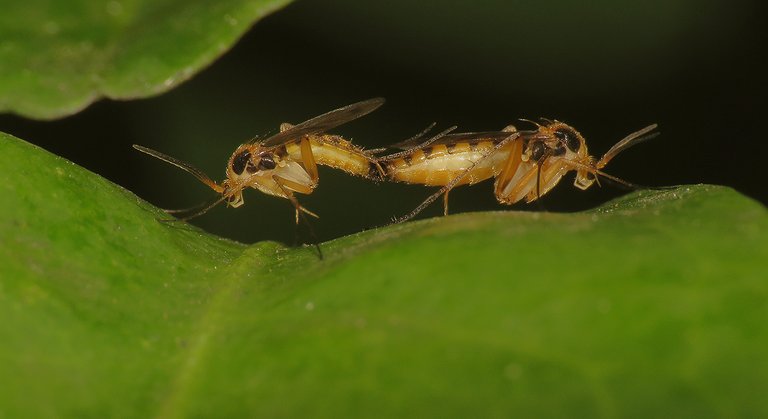
Gnats are small mosquito-like flies from the suborder Nematocera. Quite a few species that fit the aforementioned description, belonging to quite a few different families, are commonly known as gnats. In his case, you are looking at the Leia bivittata, a fungus gnat from the Mycetophilidae family.

I mean, more precisely, you are looking at the mating pair of those gnats here.
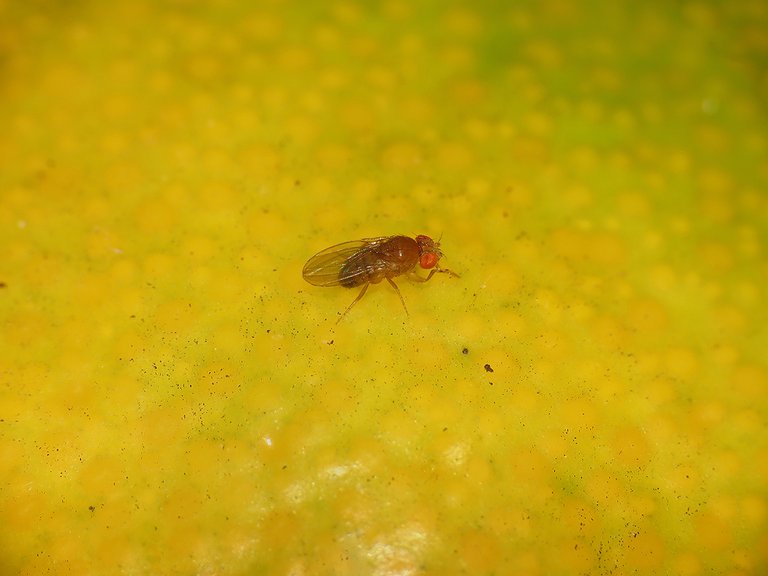
Here you can see one of the many Drosophila melanogaster flies that were present on and around the tree throughout October.
This tiny pale thing is a young nymph of some bug from the Miridae family. I wasn't able to identify the exact species.
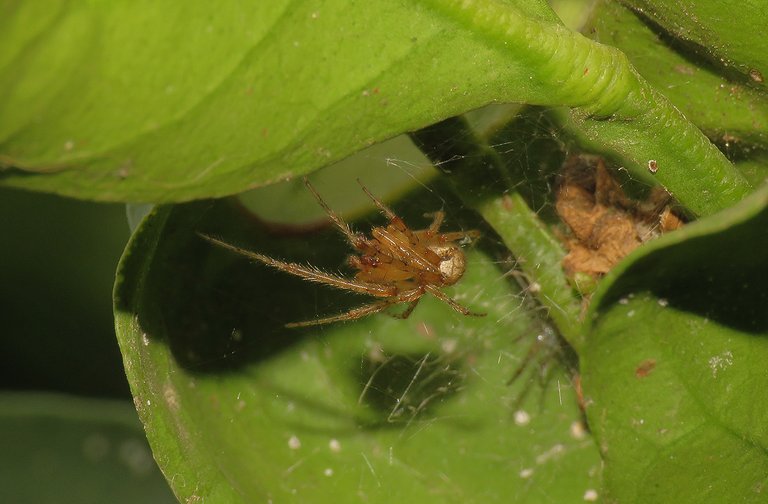
Here you can see another spider that may or may not be a member of the genus Zygiella in the Araneidae family. A similar spider appeared near the beginning of the post. I wasn't sure about its place in the arachnid world then, and I'm even less sure now.
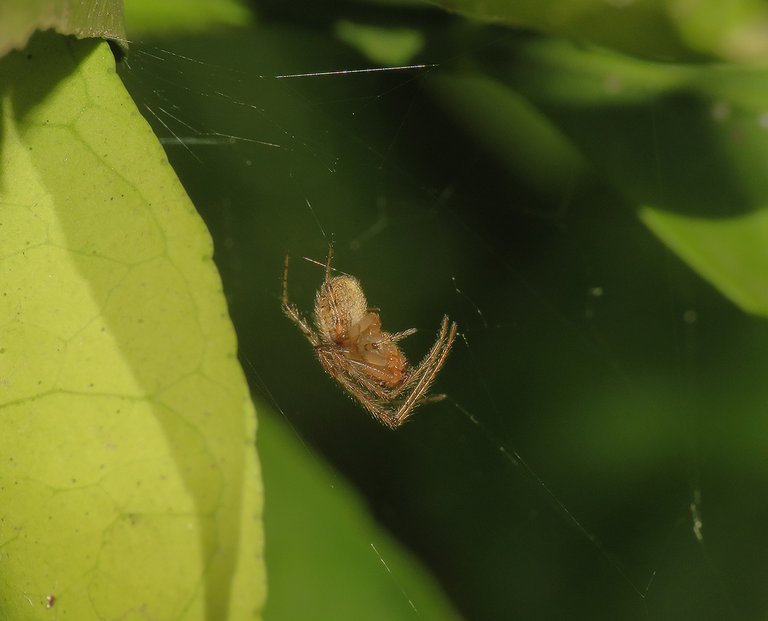
This spider was hanging on the web built among the leaves of one of the branches on the opposite side of the tree. That's all I can tell you about it.
Here you can see a small, young Cornu aspersum snail that was crawling across the planet-like sphere of the fruit in an upside-down position. The scene made me think of The Little Prince and all those planets described in the book.
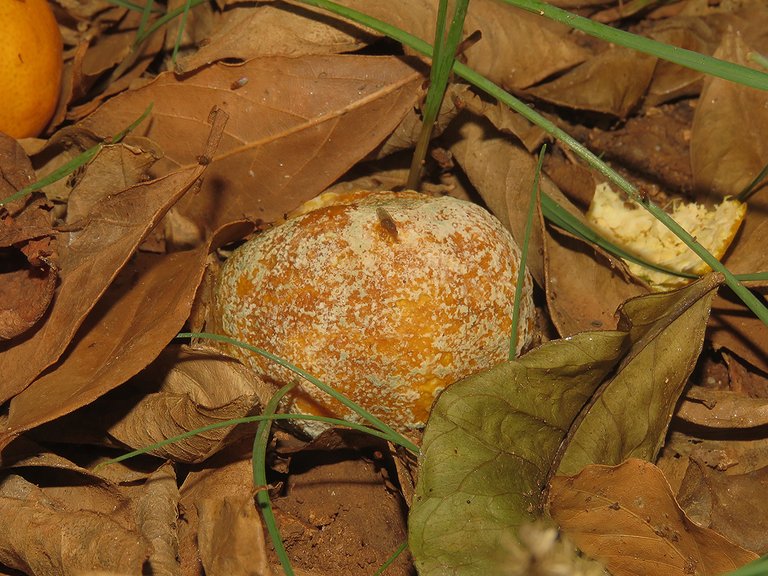
On the 23rd of October, quite a few fruits were rotting down on the ground under the tree.
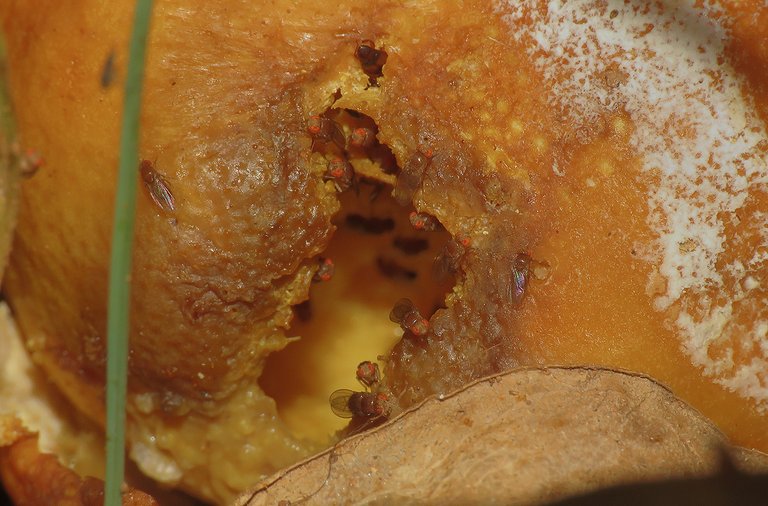
Some of them were completely empty inside. I mean, almost completely. You could always find a bunch of flies that entered through the cracks.
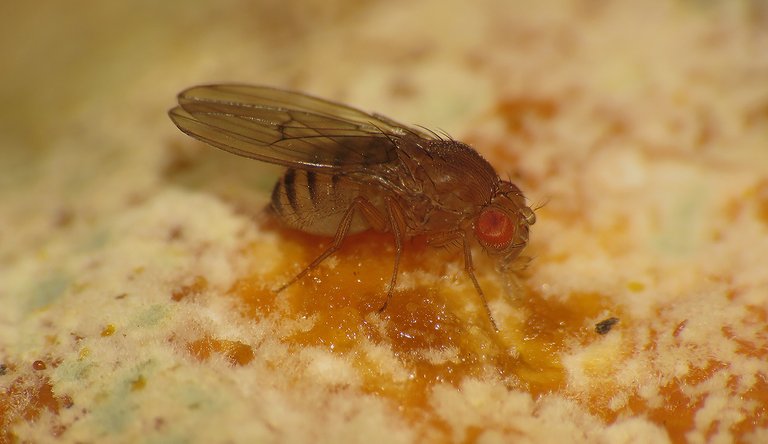
This fruit fly was feeding on the mold-covered top of the rotting fruit.
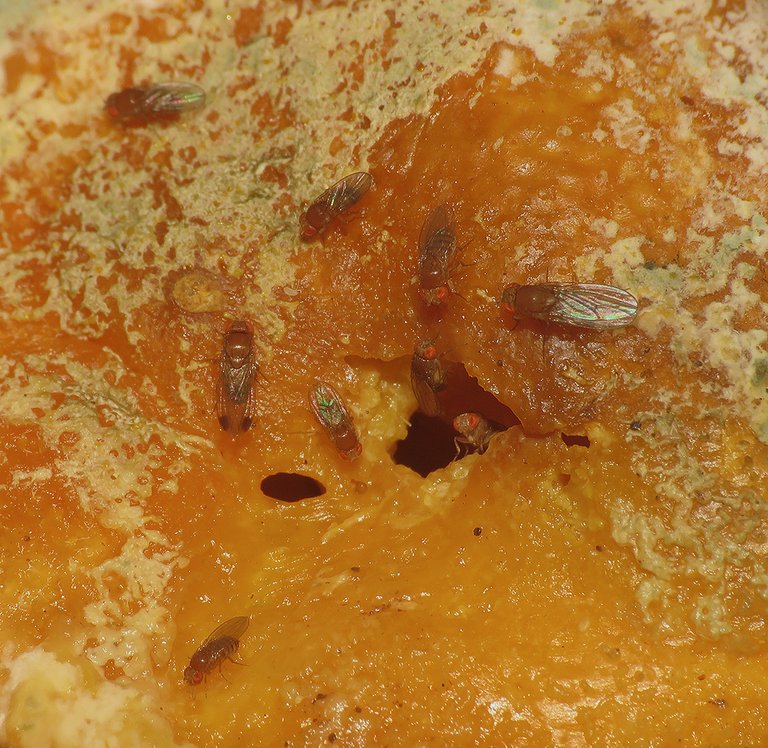
Here you can see a bunch of Drosophila melanogaster flies around the holes in the skin of another fallen tangerine.

The fruits were falling on the carpet made of a mix of rotting leaves fallen, in lesser part from the same tree, and mostly, from the surrounding bay laurel (Laurus nobilis) trees. Here you can see two dead wax scales on the dead leaf of a tangerine tree.
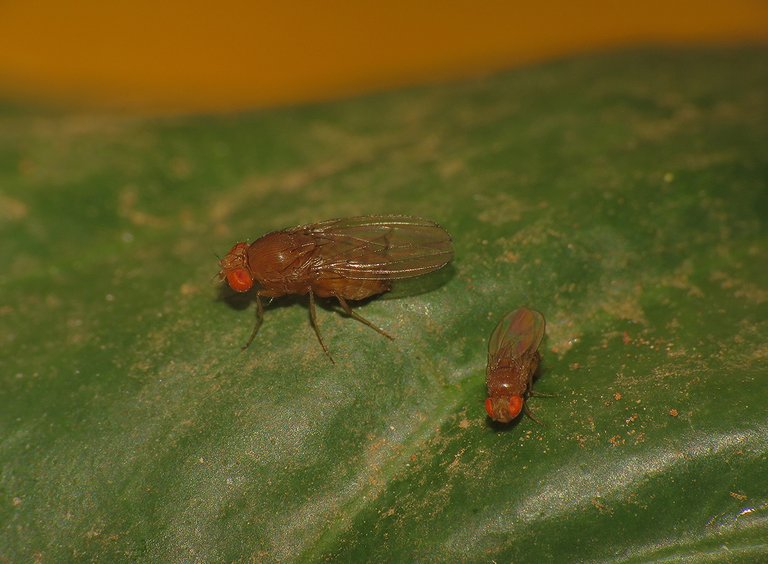
Some fruit flies weren't down on the ground, on the fallen fruits. Back then on the 23rd of October, the last day of the photographic work on my "tangerine tree project" that will eventually become this post in the January of the following year, I shot a few more fruit flies on the green foliage about a meter - meter and a half from the ground.
I photographed those flies with a flash and in natural light.
With the flash, it was easier.
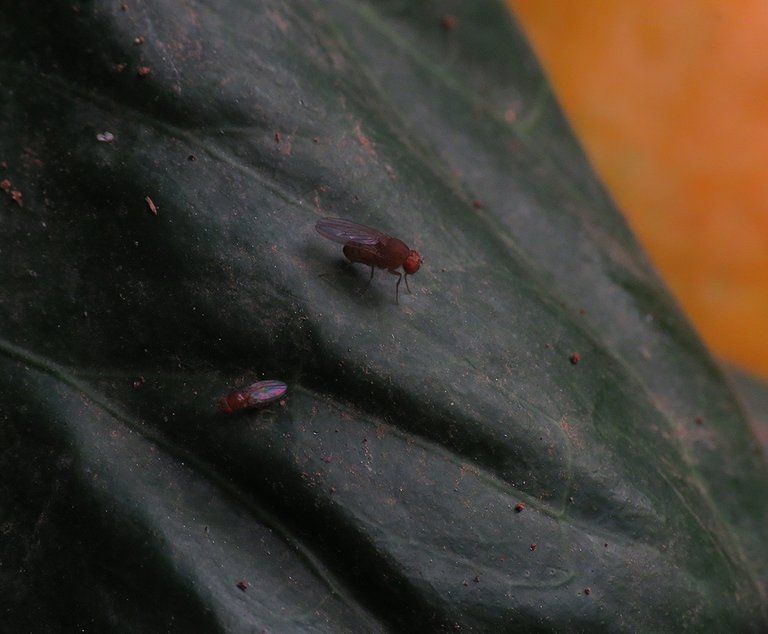
The ambient light required longer exposure and more patience ...
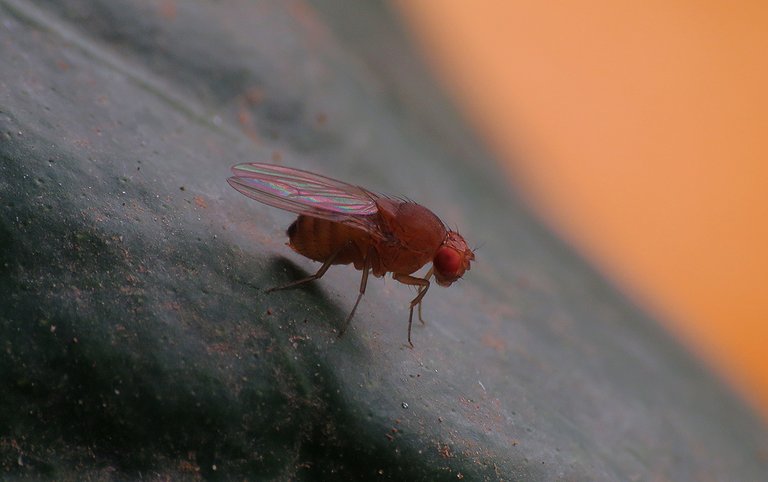
... but a portrait of a Drosophila melanogaster looked much better that way, so I had to take at least one shot with no flash involved.
The following links will take you to the sites with more information about some of the protagonists of this post. I found some stuff about them there.
https://en.wikipedia.org/wiki/Brown_marmorated_stink_bug
https://en.wikipedia.org/wiki/Icius_hamatus
https://en.wikipedia.org/wiki/Cornu_aspersum
https://wiki.bugwood.org/Ceroplastes_japonicus
https://en.wikipedia.org/wiki/Exochomus_quadripustulatus
https://gardensafari.net/en_picpages/exochomus_quadripustulatus.htm
https://en.wikipedia.org/wiki/Zygiella
https://nzacfactsheets.landcareresearch.co.nz/factsheet/InterestingInsects/Forestiers-ladybird---Rhyzobius-forestieri.html
https://en.wikipedia.org/wiki/Phaneroptera_nana
https://en.wikipedia.org/wiki/Nigma_walckenaeri
https://srs.britishspiders.org.uk/portal.php/p/summary/s/nigma+walckenaeri
https://en.wikipedia.org/wiki/Chrysoesthia_drurella
https://en.wikipedia.org/wiki/Zygiella_atrica
https://bugguide.net/node/view/90412/bgimage
https://en.wikipedia.org/wiki/Chamaemyiidae
https://en.wikipedia.org/wiki/Drosophila_melanogaster
https://en.wikipedia.org/wiki/Leptopilina
https://en.wikipedia.org/wiki/Sarcophaga_africa
https://en.wikipedia.org/wiki/Ditula_angustiorana
https://en.wikipedia.org/wiki/Clogmia_albipunctata
https://en.wikipedia.org/wiki/Rhagionidae
https://en.wikipedia.org/wiki/Leia_bivittata
https://bugguide.net/node/view/684262/bgimage
AND THAT'S IT. AS ALWAYS IN THESE POSTS ON HIVE, THE PHOTOGRAPHS ARE MY WORK.


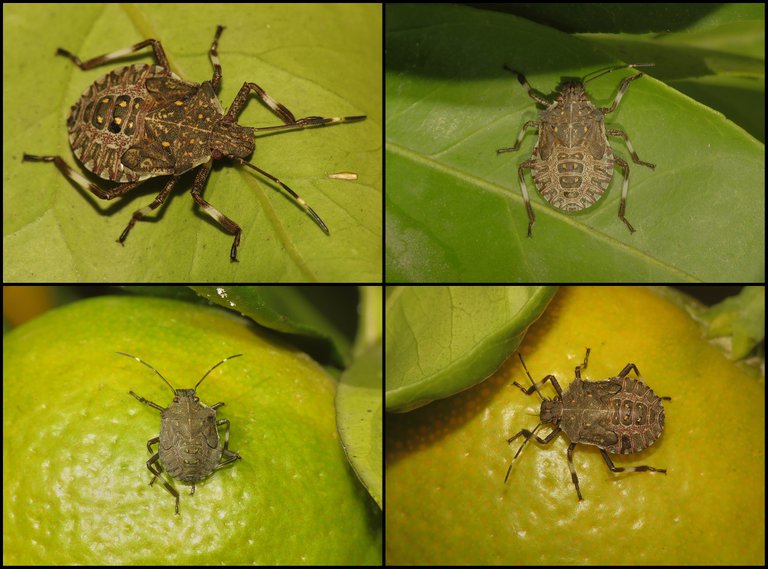

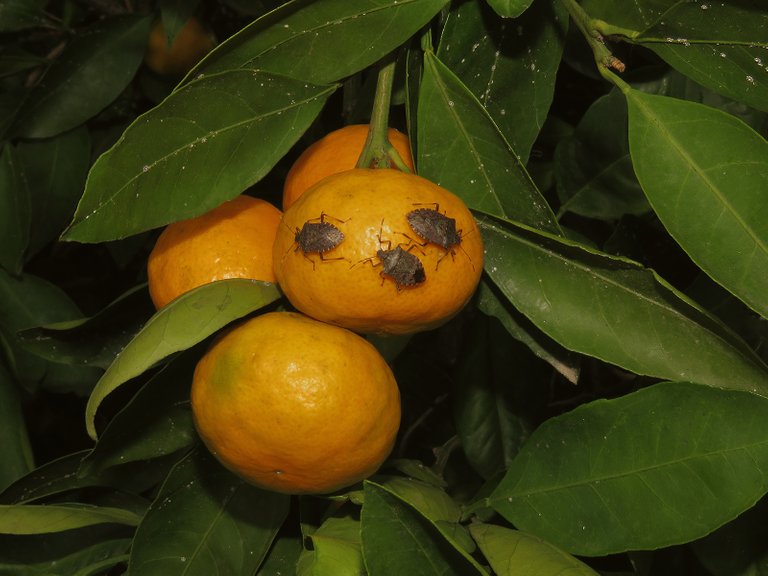

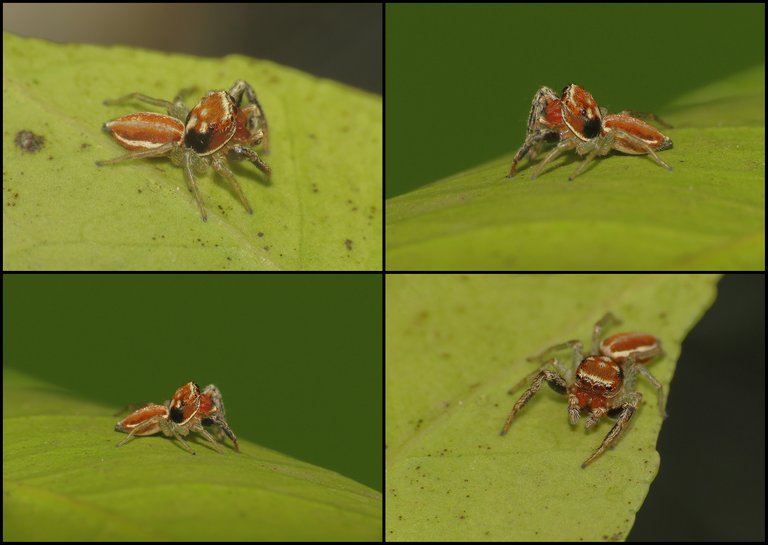
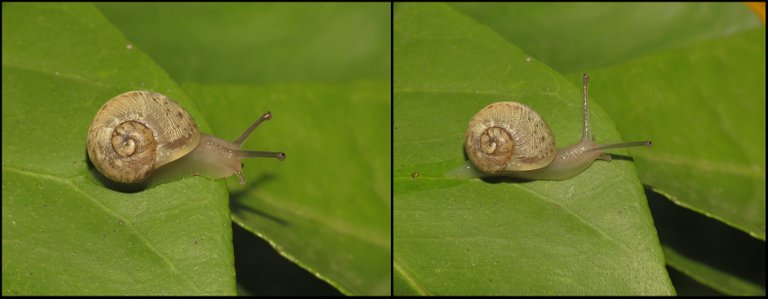

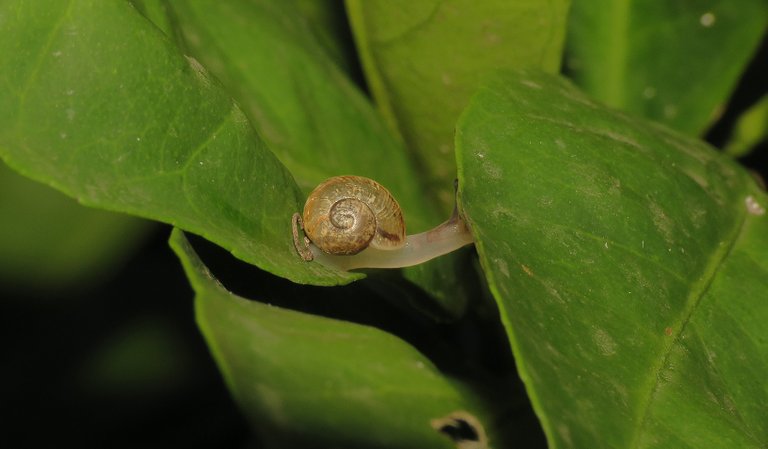

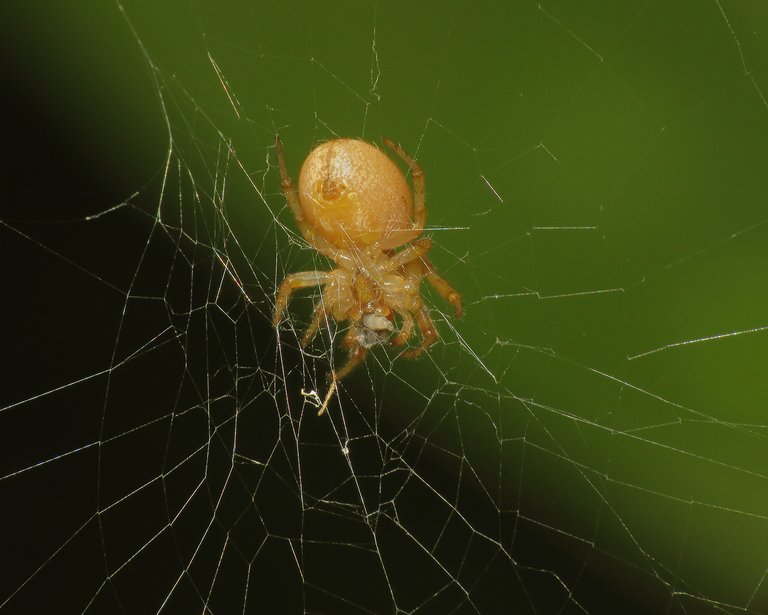
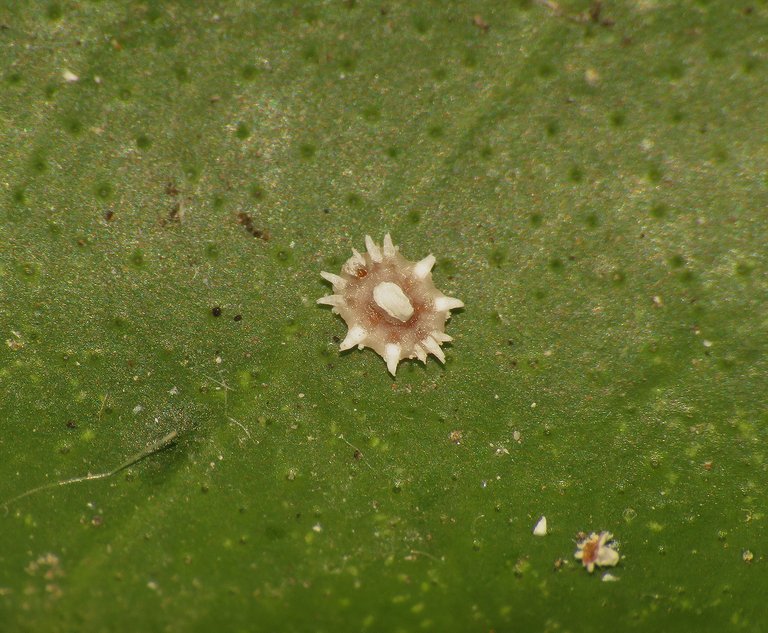

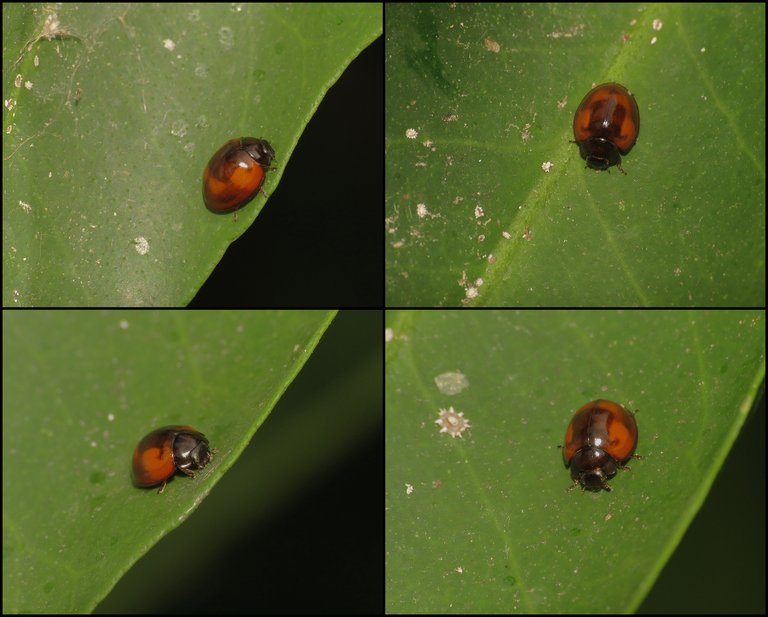
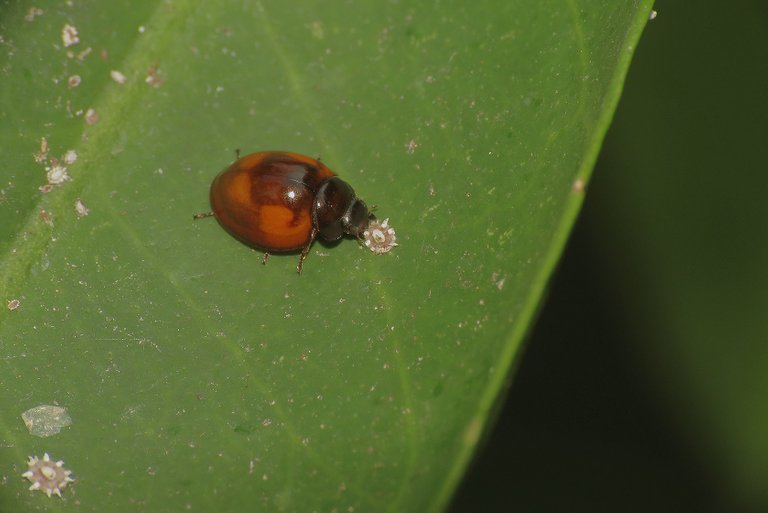
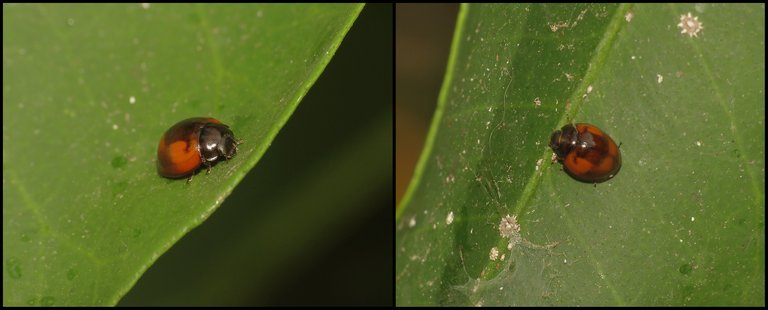
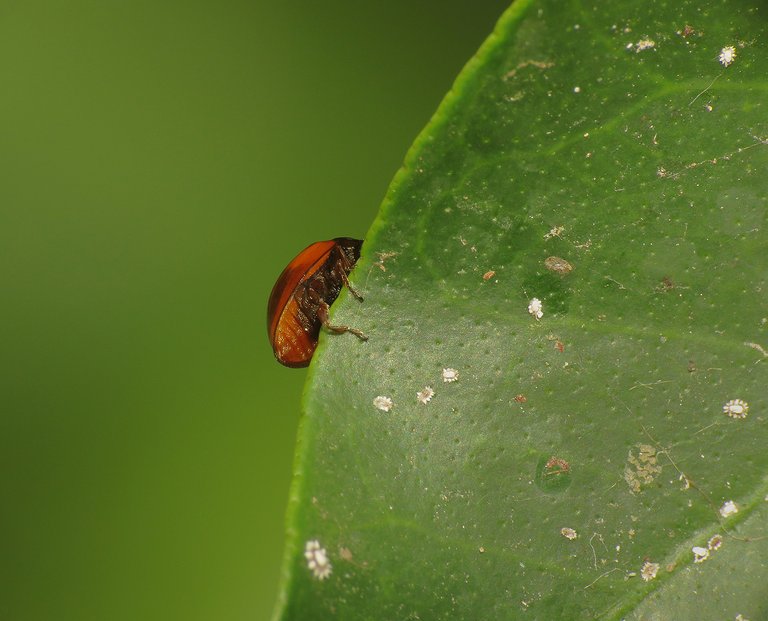

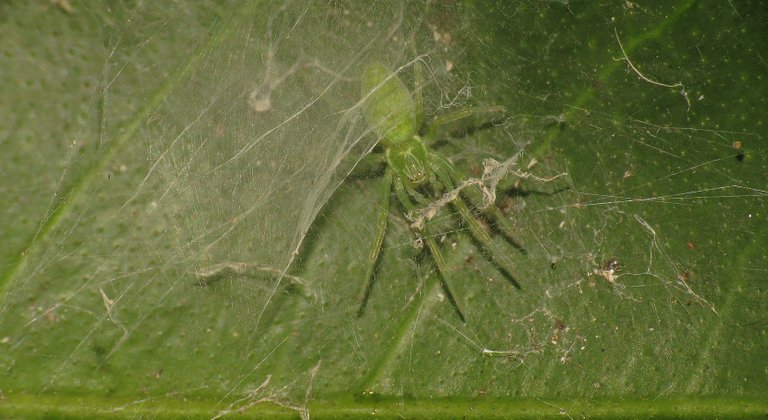

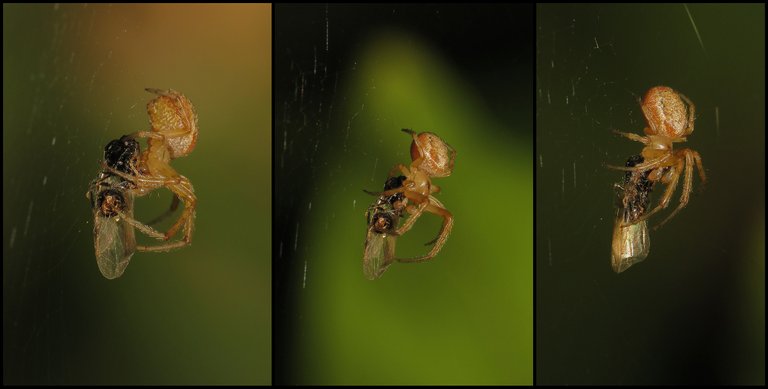
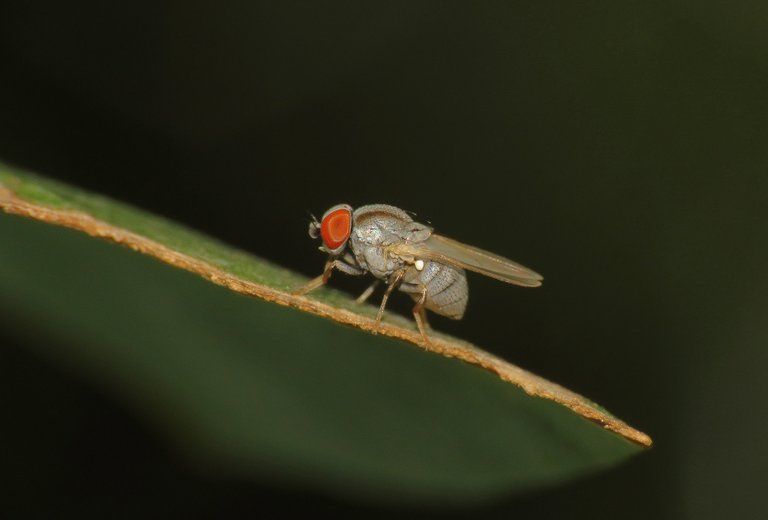


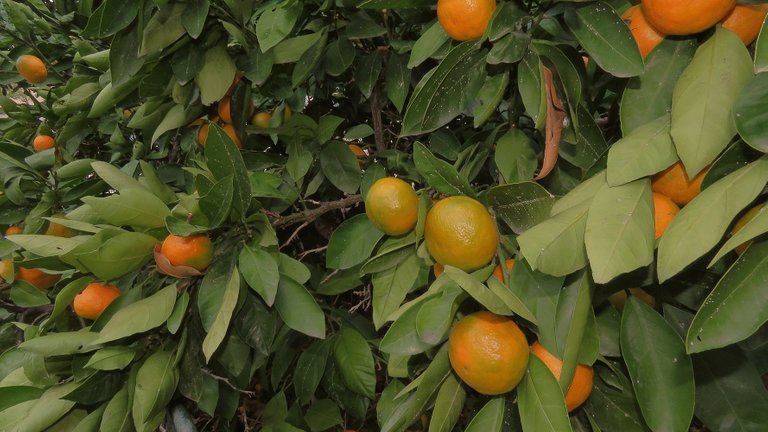
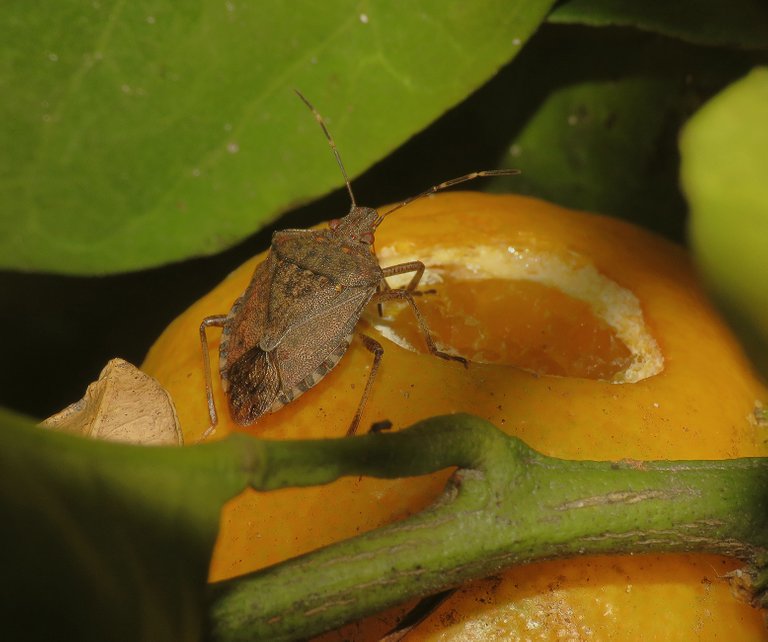
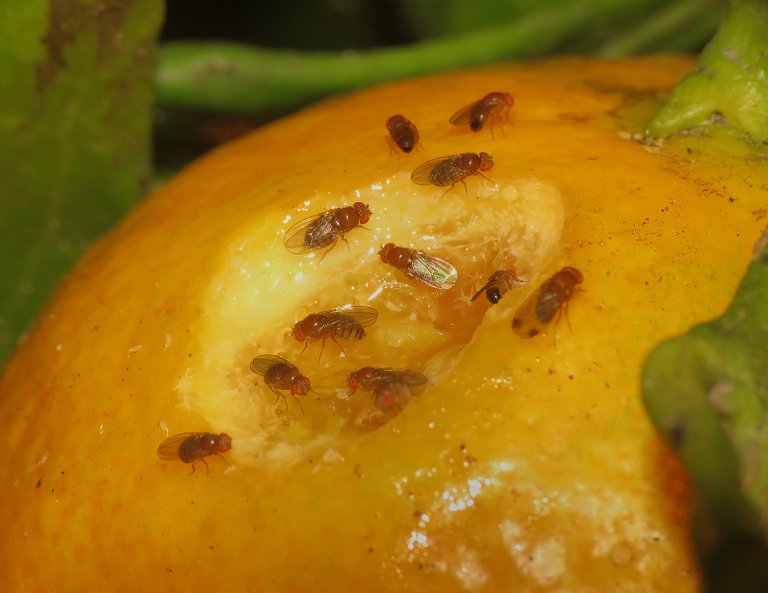
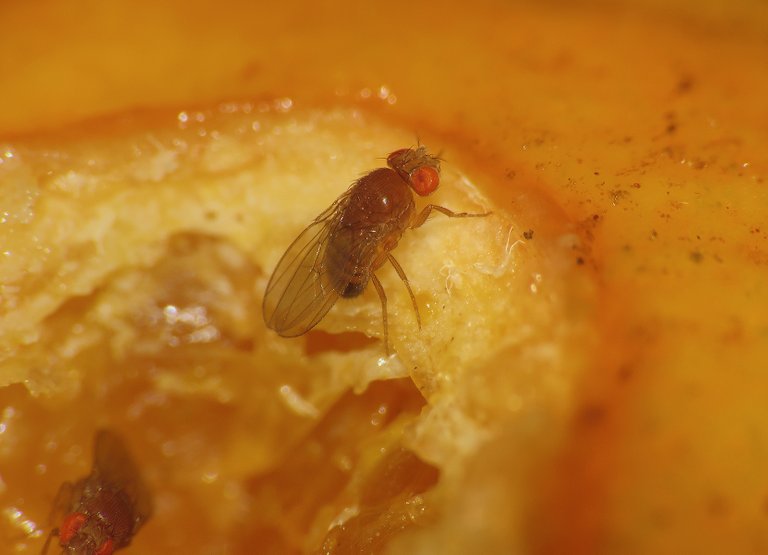
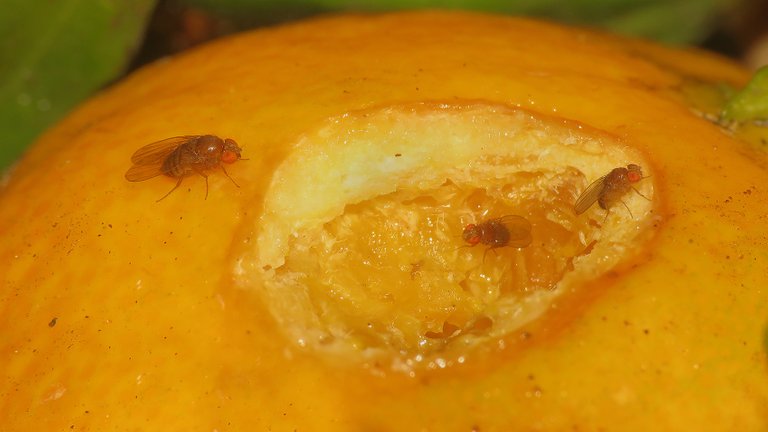
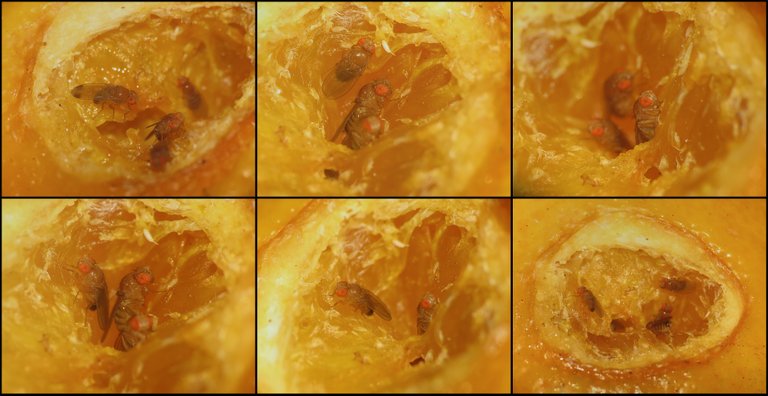
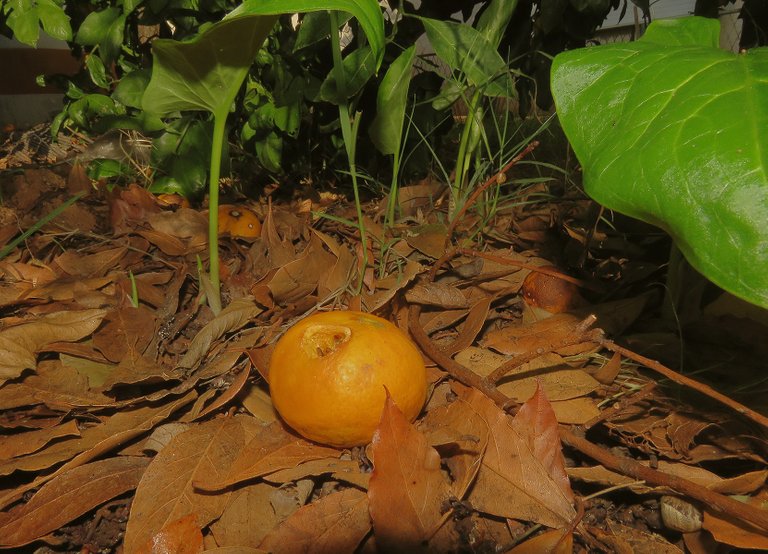

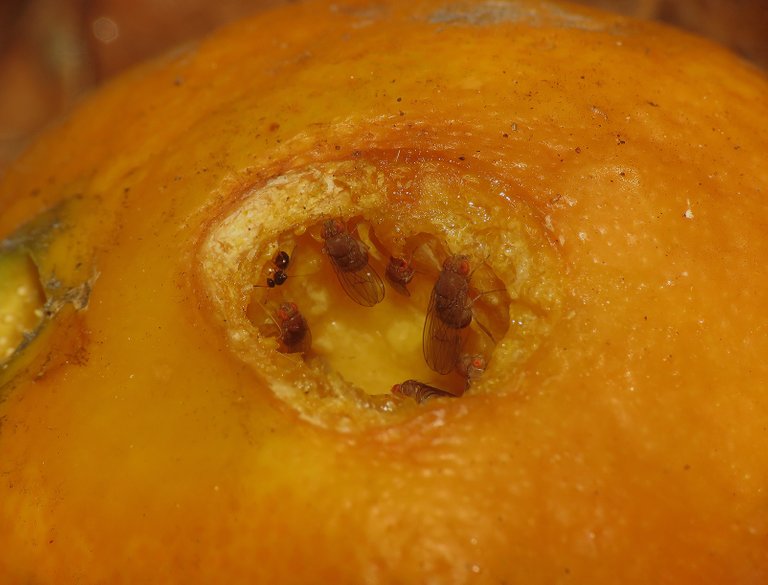
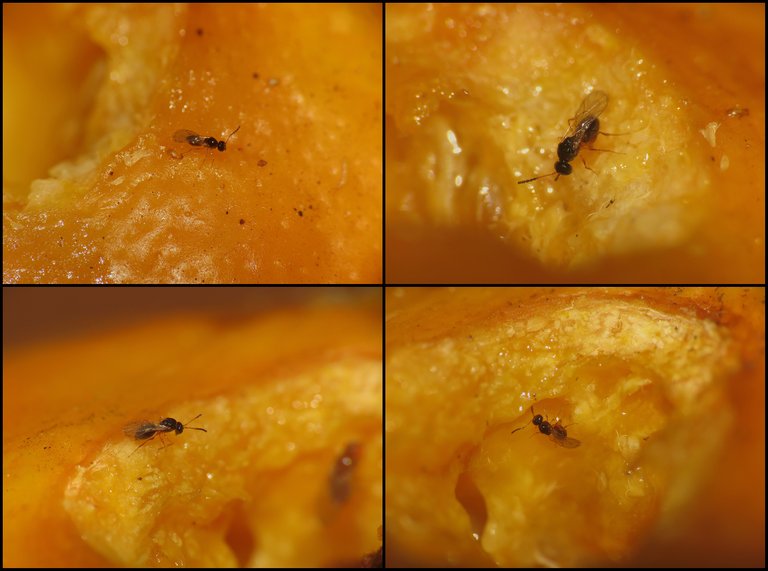

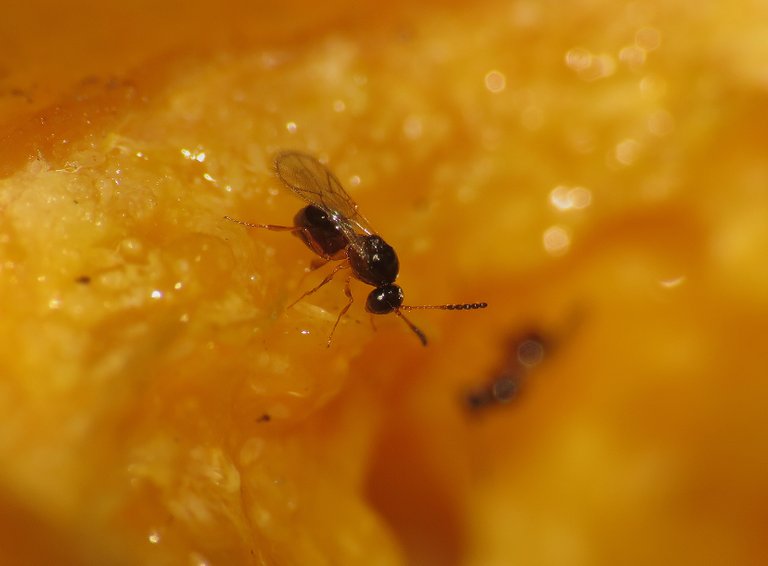
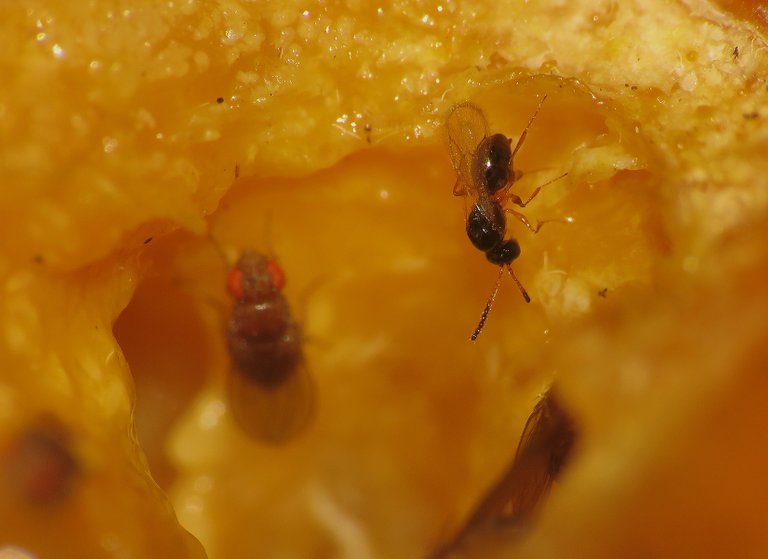
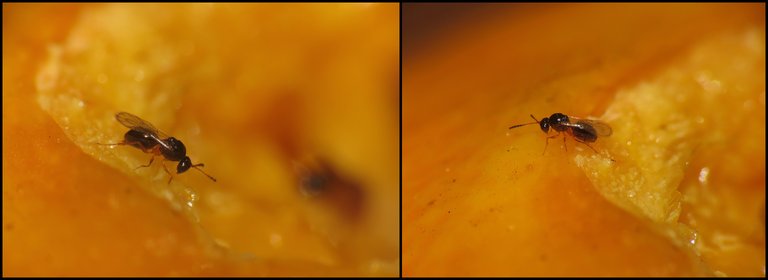
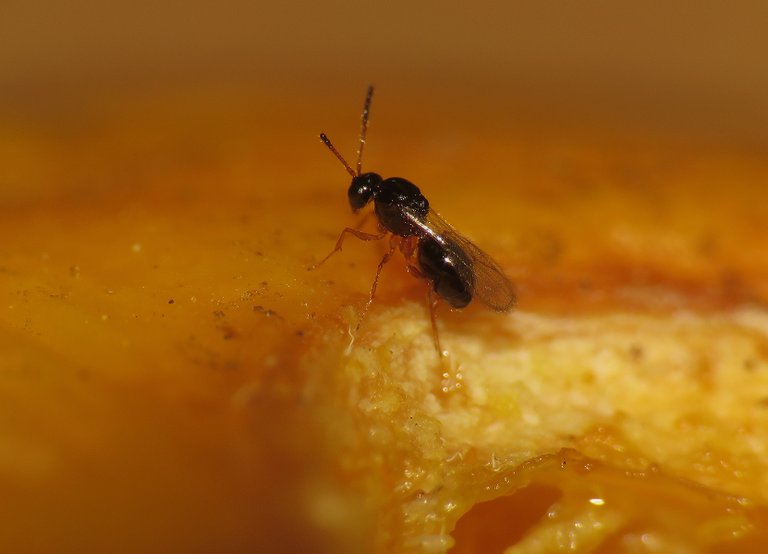
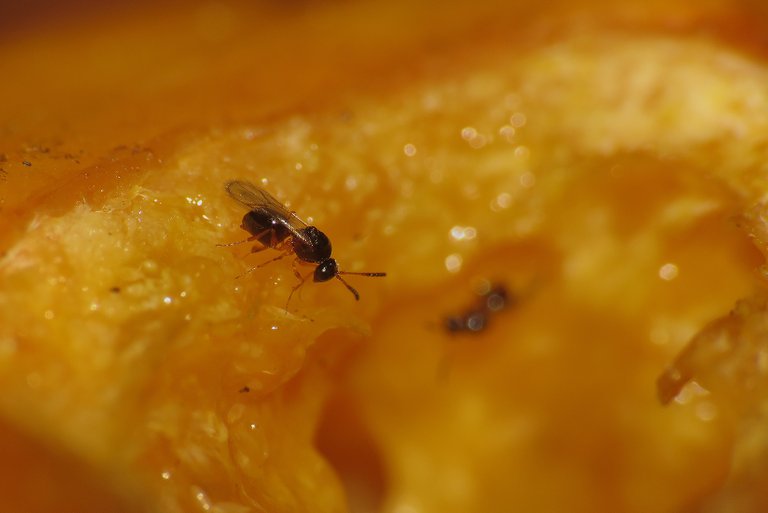
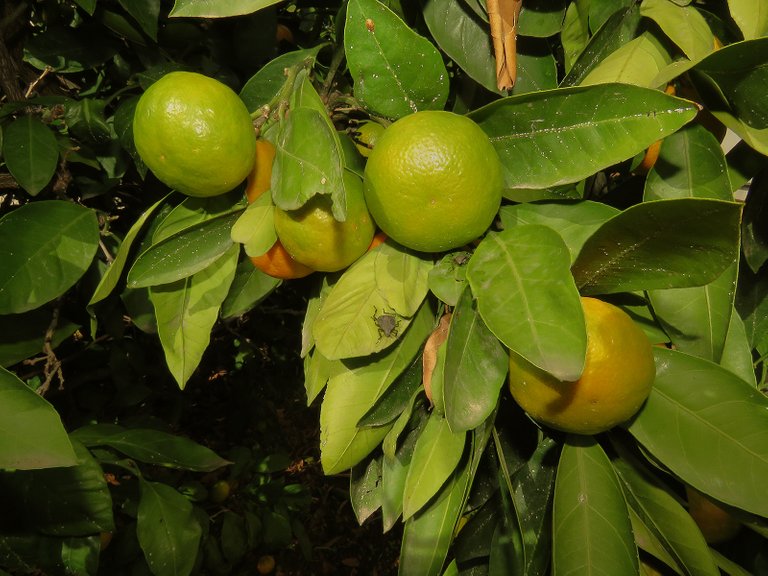
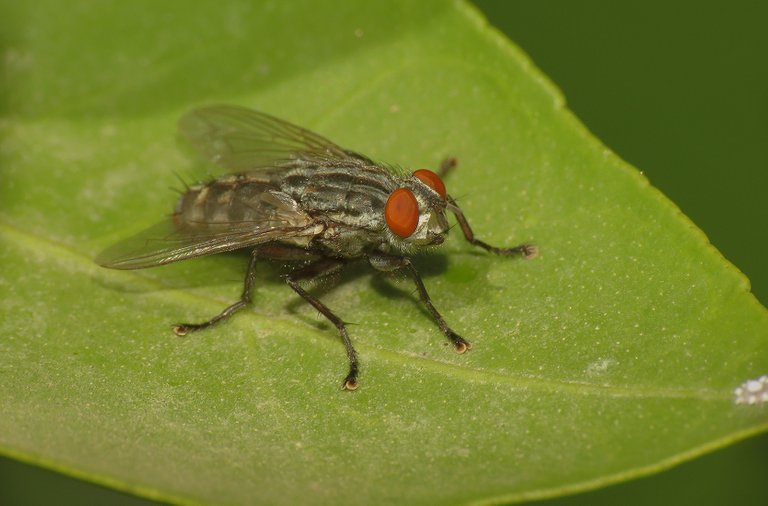
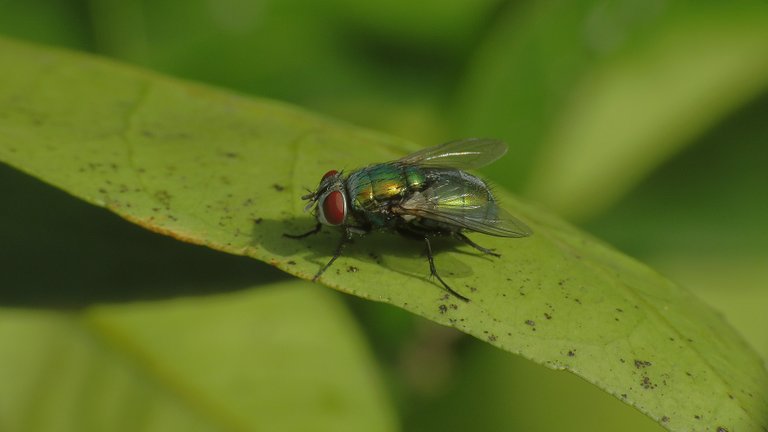
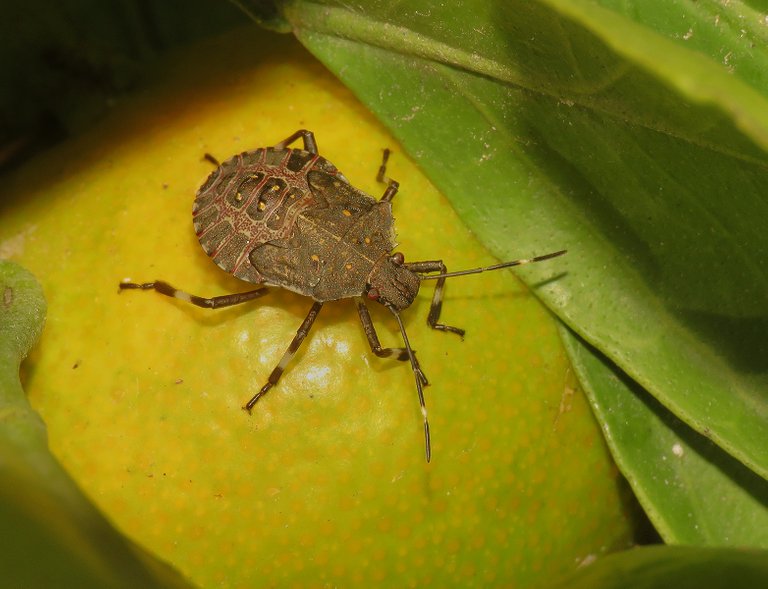
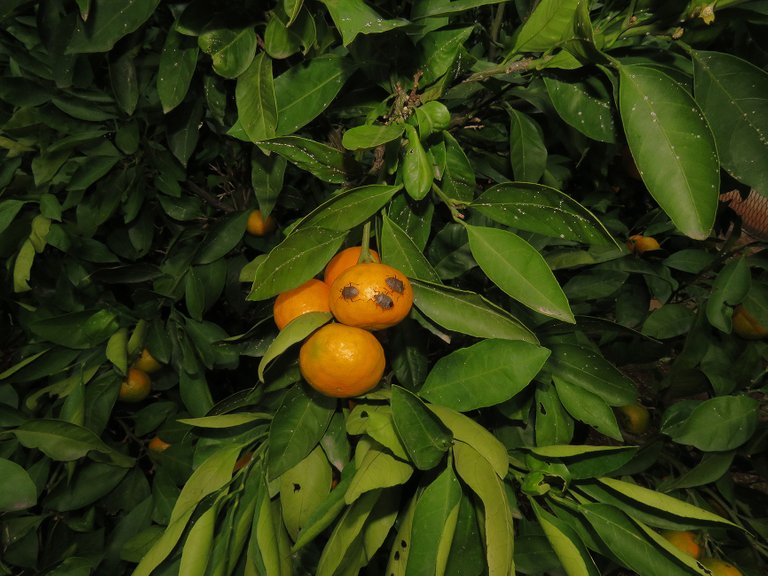
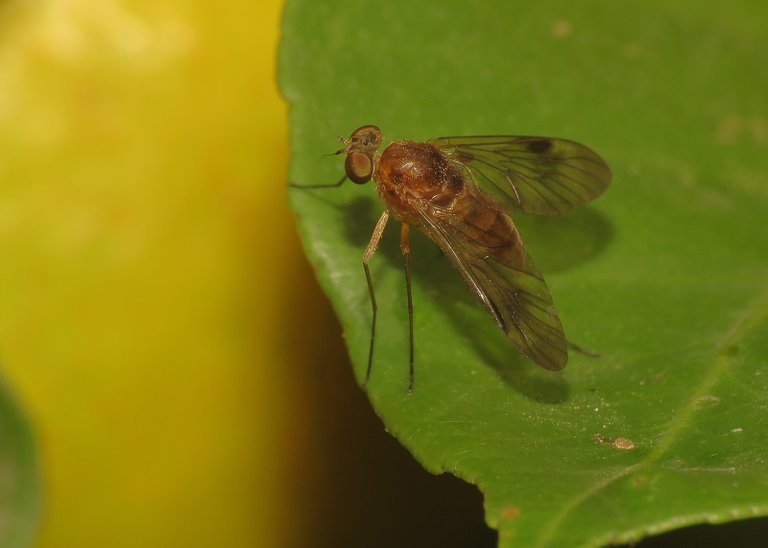
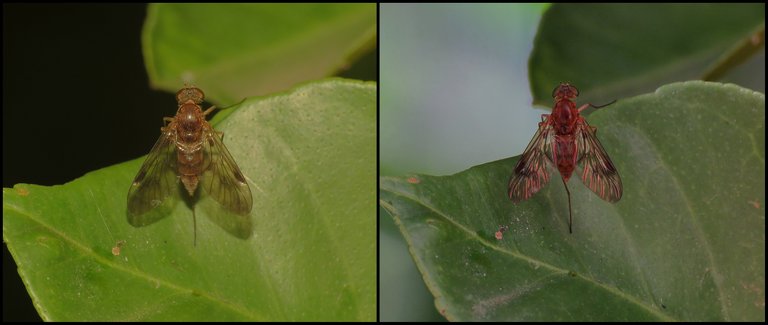

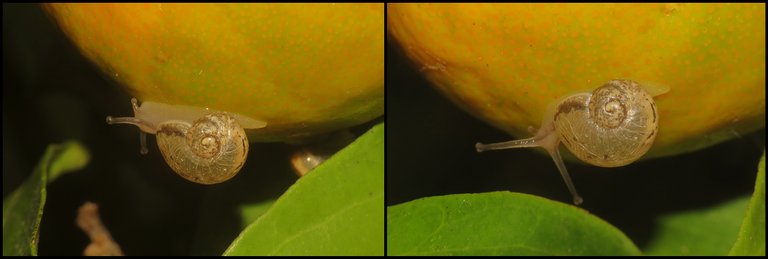
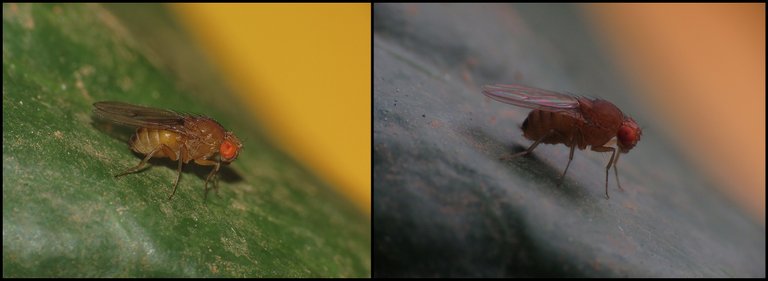
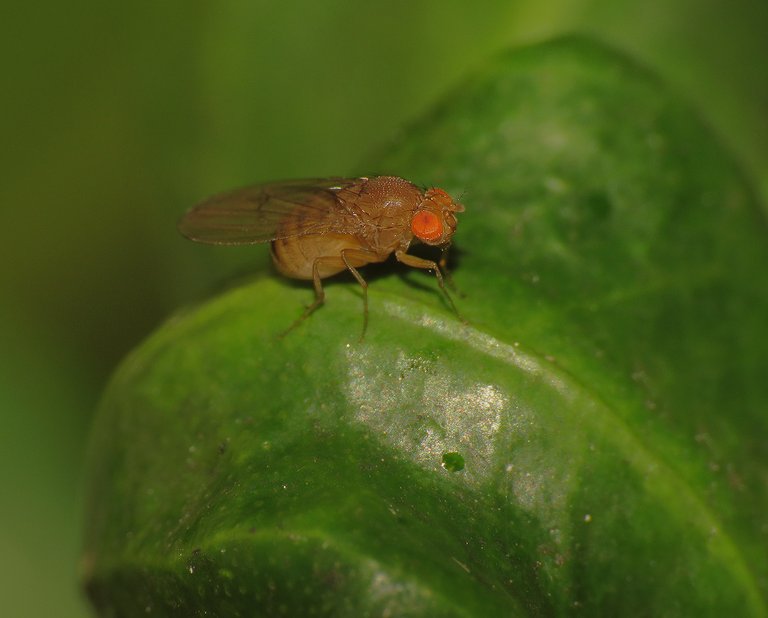
So tiny all insect and usually they more active in the night but you are very lucky found it ini your camera. Nice shot and good words sir @borjan. God bless you
The snails 🐌, what strange creatures they are. I'm struggling to keep my plants safe from them! The red beetle on all the greenery really pops out. And on the other hand the green spider and grasshopper blends so well into the background. Never thought that one would find so many creatures on fruit trees, people always keep them away with pesticides, I'm glad you could get these photographs 🍀
Nice post. There are having sooo many insects
https://twitter.com/1602924208522203137/status/1620704637757325312
The rewards earned on this comment will go directly to the people( @nishani9 ) sharing the post on Twitter as long as they are registered with @poshtoken. Sign up at https://hiveposh.com.
Congratulations @borjan! You have completed the following achievement on the Hive blockchain And have been rewarded with New badge(s)
You can view your badges on your board and compare yourself to others in the Ranking
If you no longer want to receive notifications, reply to this comment with the word
STOPCheck out our last posts:
Congratulation sir @borjan for your achievement as buzzy bee 👍👍👍👍
You're welcome @elchaleefatoe15, it's well deserved! Congrats on your constant involvement on Hive 😊👍
We often see such insects sitting on various fruits or vegetables. All the moths look very beautiful. You have done a lot of beautiful photography.
So many on this tree… so much to photograph.
The fly that looks like a tiny moth is pretty. Never seen one.
The jumping spider is just cute. I like seeing them in your photos.
The shot with the spiders den and ladybug resting is cool.
Nice captures @borjan 👋🏻😊 have a great Wednesday!
🙂
Better to spray it with GARLIC! They will not come there! Believe me. That is what I am doing to my plants! naturally...
Yes, garlic is a powerful thing.
The Chrysoesthia drurella has such unique markings and lovely color.
The Halyomorpha halys nymphs have much more interesting markings than the mature adult.
Ditula angustiorana is another cool looking moth. The patterns on the wings are so different...
Loved this study of the tangerine tree and insects.
Thank you. 🙂Glad you like the post. I had fun exploring the tree and photographing the small creatures.
Congratulations, your post has been upvoted by @dsc-r2cornell, which is the curating account for @R2cornell's Discord Community.
Buen dia mi amigo @borjan que insectos tan extraños los que 🤔 estan en las mandarinas, parecen 🦀 cangrejos miniaturas.
🙂
I really like Tangerines, sweeter and more juicy than Oranges. I guess many insects love them too !LOL
Quick question.... How on earth did you manage for those flies to sit still while you move about them taking photos 😂 that in itself is an art!!
Even though I hate spiders you took some nice pics of them. If it was me I'd have smacked them😂👀
😀 I'm moving slowly and I whisper to the flies. 😂
I'm truly amazed by your sense of photography @borjan, you are truly a gem to this community, never ever thought of capturing these insects. can't even get close to them. I just can't think of going this much close to them. it's always good to see you are doing this and you are one of the best photographer i have ever seen.
Thank you. 🙂 Glad you like the post.
You really got yourself some farm buddies✨
🙂
Well both insects and animals and predators enjoy the fruits
So much snails in our place eating my wife's plants.